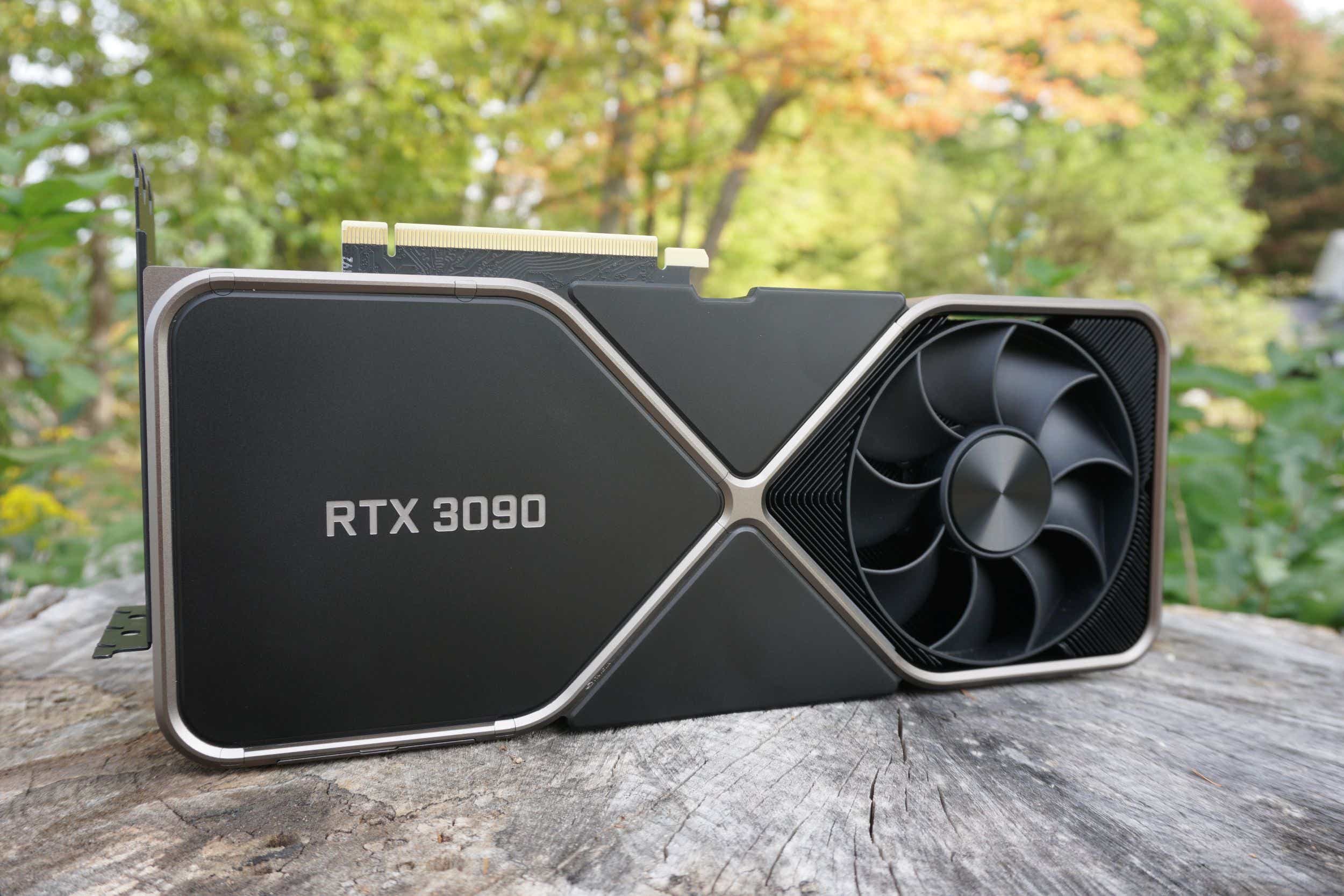 At a Glance
At a GlanceExpert's Rating
Pros
- Excellent 4K and 1440p gaming
- As fast as RTX 2080 Ti for $700 less
- Cool, reasonably quiet custom cooling
- Ray tracing at 1440p and (sometimes) 4K
- HDMI 2.1, AV1 encoding, PCIe 4.0, 8K/30fps capture
- Nvidia software: Reflex, G-Sync, Shadowplay, Broadcast, RTX IO
Cons
- 8GB of memory doesn’t feel future-proof for 4K gaming
- Not as quiet as other RTX 30 Founders Edition GPUs, some custom cards
- 12-pin power adapter is ugly
Our Verdict
The Nvidia GeForce RTX 3070 Founders Edition delivers performance on a par with last generation’s flagship for $700 less, but compromises on memory capacity. It’s a great graphics card for 4K or high-refresh-rate gaming.
Best Prices Today: GeForce RTX 3070 Founders Edition
“Faster than the 2080 Ti.” That’s the promise Nvidia CEO Jensen Huang made while revealing the GeForce RTX 3070 in September, and it’s a scintillating one. The GeForce RTX 2080 Ti sat atop Nvidia’s RTX 20-series graphics card stack, offering performance as scalding as its $1,200 price tag. Could the $500 GeForce RTX 3070 and its new-look Ampere GPU really go toe-to-toe with the last generation’s luxurious flagship for a whopping $700 less?
Spoiler alert: Yep. It wins some and loses some, but on the whole, the GeForce RTX 3070 is effectively just as fast as the RTX 2080 Ti in gaming (and much more so in some creative tasks) for well under half the price. And it absolutely smokes its RTX 2070 predecessor. That’s a massive step forward for PC gamers—but AMD’s counterpunch looms, with the Radeon RX 6000 series scheduled to be unveiled Wednesday. Whether the GeForce RTX 3070 continues to rock oursocks in the wake of AMD’s announcement remains to be seen, but at least for one day, Nvidia’s new graphics card rules the school.
Let’s dig in.
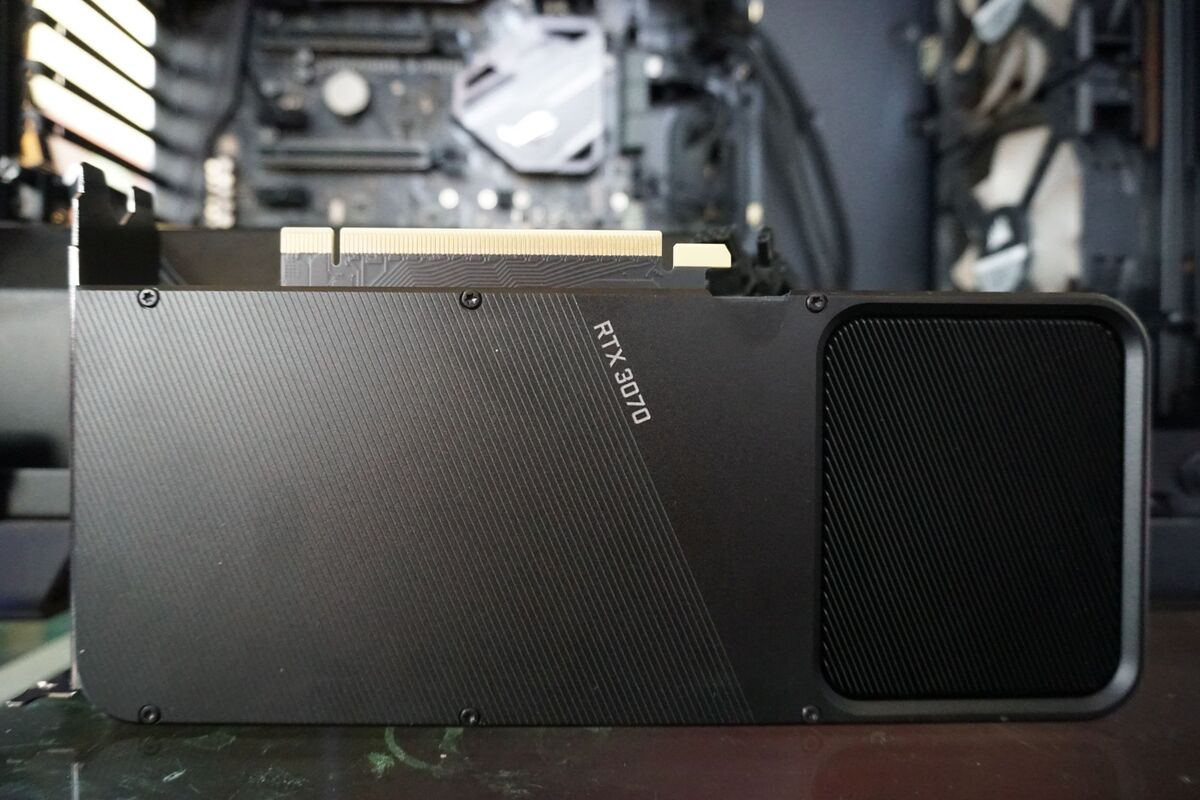 Brad Chacos/IDG
Brad Chacos/IDG
The backplate of the RTX 3070 Founders Edition.
Nvidia GeForce RTX 3070: Specs, features, and price
First, the technical info, as the RTX 3070 Founders Edition differs quite a bit from previously released RTX 30-series graphics cards.
While the GeForce RTX 3080 and RTX 3090 use Nvidia’s biggest “GA102” Ampere GPU, the new GeForce RTX 3070 is built using the smaller “GA104” GPU. This GPU supports up to 48 streaming multiprocessors in its full incarnation, but the RTX 3070 pares that back slightly with 46 SMs, presumably to help compensate for potential defects during the manufacturing process. Check out our RTX 3080 review or Nvidia’s own Ampere whitepaper for a deeper look at the most significant architectural changes, as we won’t be rehashing those GPU-level technical details here.
Here’s a high-level look at the $500 GeForce RTX 3070’s insides and outsides, compared against the tech specs for its predecessor, the $500 RTX 2070, and the $1,200 RTX 2080 Ti that Nvidia is so keen to compare it against.
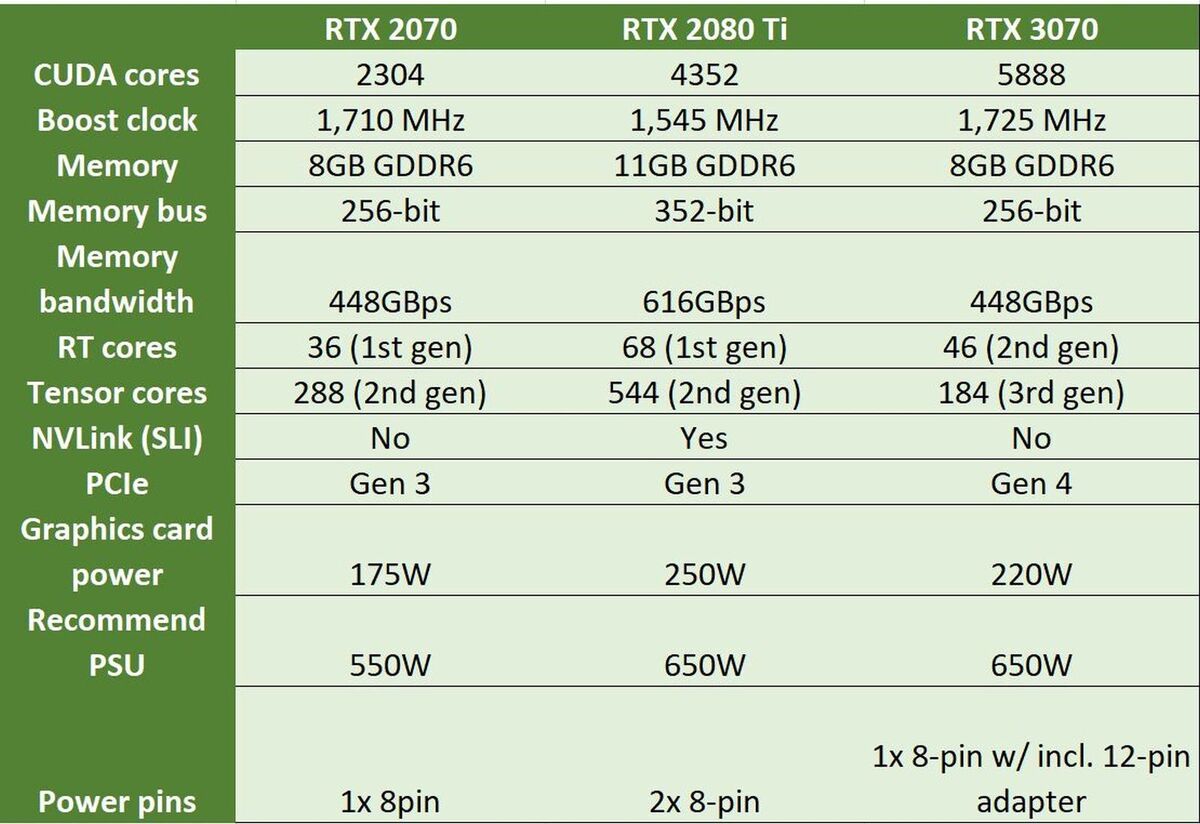 Brad Chacos/IDG
Brad Chacos/IDGThe “Ampere” GPUs in the RTX 30-series sport a new design that effectively doubles the CUDA core count compared to the older generation. Not all of those can be used at once in most games, however, so performance doesn’t scale linearly. Likewise, the RTX 3070 packs more advanced RT and tensor cores—the dedicated hardware used for ray tracing and AI tasks like DLSS, respectively—than the last-gen GPUs, so don’t be scared off by the lower counts there. This card handles real-time ray tracing on a par with what the RTX 2080 Ti could handle, and it’s clocked much higher.
Memory is the biggest difference here. The RTX 3080 and 3090 upgraded to much faster, much more efficient GDDR6X memory, which gives those cards hefty bumps to overall memory bandwidth. The GeForce RTX 3070 doesn’t. It comes with the same 8GB of GDDR6 memory as last-gen’s RTX 2070, over the same 256-bit bus. That’s a disadvantage compared to the RTX 2080 Ti it usurps, both in raw capacity (8GB vs 11GB) and overall memory bandwidth (448GBps vs. 616GBps). It shouldn’t make a difference at 1440p resolution, but you have to wonder if 8GB of GDDR6 will be enough for 4K gaming in a couple of years, especially because the PlayStation 5 and Xbox Series X consoles are both moving to 16GB of VRAM when they launch in a couple of weeks. Today, though, it’s fine for the vast majority of 4K games.
Despite the RTX 3080 and RTX 3090’s earned reputation as power hogs, the GeForce RTX 3070 shows that Ampere is indeed more power-efficient than the Turing GPUs inside the older RTX 20-series. The GeForce RTX 3070 delivers performance roughly on a par with the former RTX 2080 Ti flagship, but the newer graphics card consumes 30 watts less power, and drops from 2x 8-pin connectors to a single 8-pin connector. That said, it still draws significantly more than the RTX 2070 it’s replacing, which drew 70W less and could run on a less potent power supply.
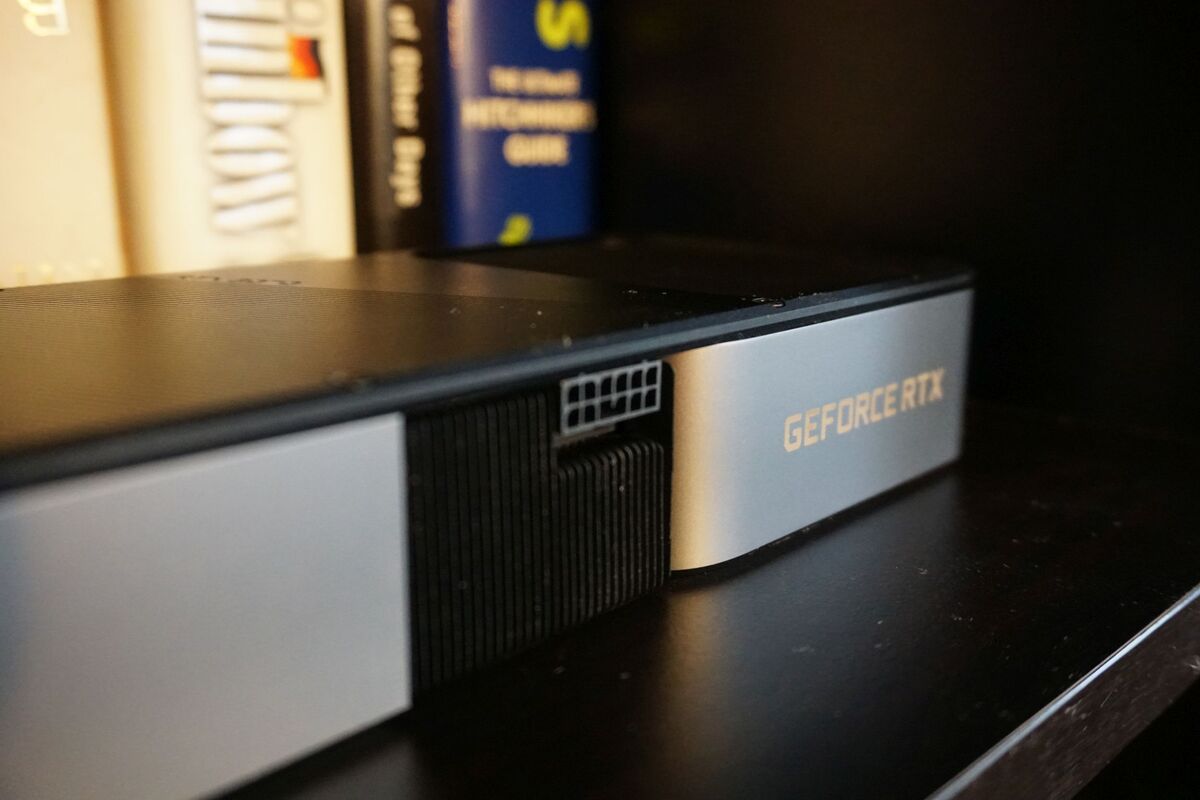 Brad Chacos/IDG
Brad Chacos/IDG
The RTX 3070 FE still uses Nvidia’s proprietary 12-pin connector, but in a different place than other Founders Edition models.
The Founders Edition model we’re reviewing today still uses Nvidia’s tiny, highly customized PCB with a notch taken out of it to help with airflow. This means that like the other FE cards revealed so far, it powers on via a proprietary 12-pin connector. Nvidia includes an (ugly, short) adapter in the box. Unlike the more powerful RTX 30-series Founders Edition cards, however, the 12-pin connector is located horizontally in the middle of the edge of the card, rather than positioned vertically and at a 45-degree angle. If your case’s power supply shroud has a cutout for wires underneath your GPU, this is a much better placement.
That’s not the only design change. Nvidia created a highly unique custom “flow-through” cooling solution for the RTX 3080 and RTX 3090, with independent push-pull fans and bristling, thick metal heat fins comprising the body of the card itself. It’s very effective.
The GeForce RTX 3070 changes things up a wee bit. Rather than having one fan on the top and the bottom of the card in a push-pull configuration, the RTX 3070 FE places both fans in their standard places in the face of the card and adds a sleek backplate to the top. The two fans pushes air through the heatsink; the blower-style fan at the rear of the card expels heat through the 3070 FE’s I/O bracket, while the other one sends the hot air through a cut-out in the backplate back into the top of your system, where it can be sucked out by your case’s rear outtake fan. It’s functionally the same idea as the cooler on the more powerful RTX 30-series cards, but it takes a different path to get there.
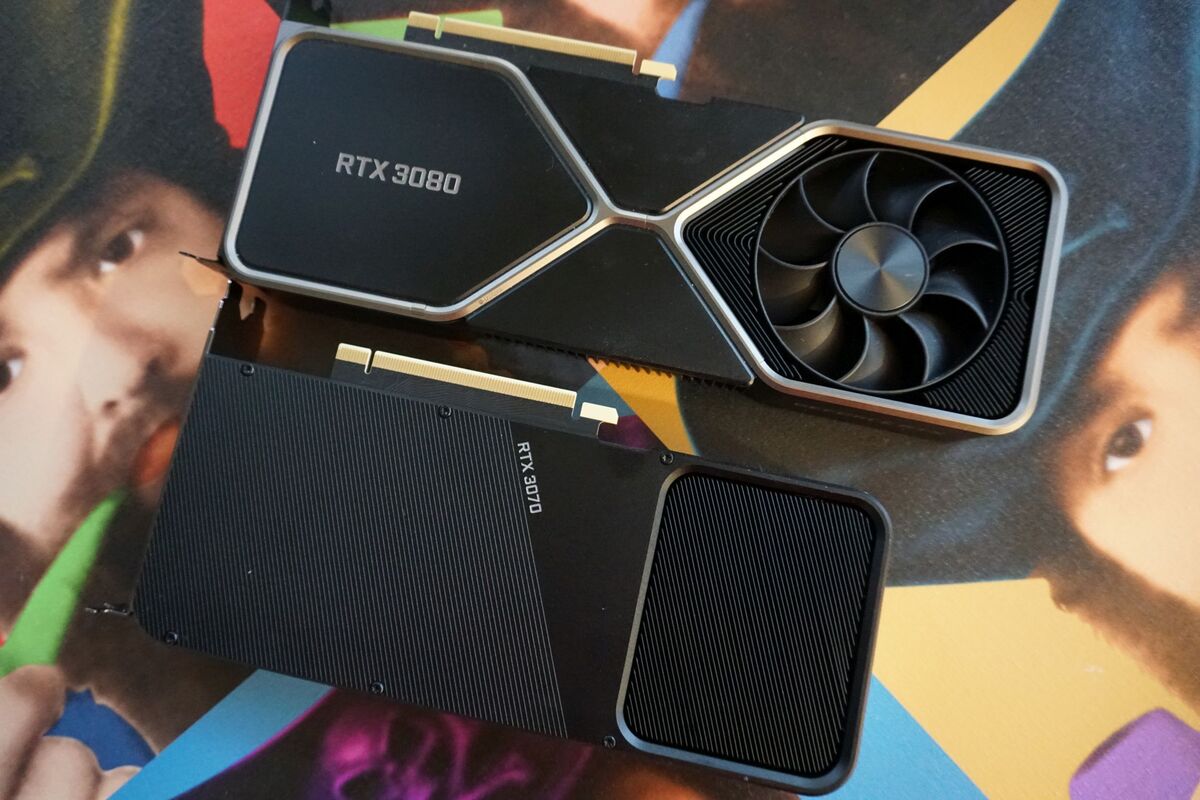 Brad Chacos/IDG
Brad Chacos/IDG
RTX 3080 Founders Edition (top) vs. RTX 3070 Founders Edition (bottom)
Between the cooler redesign and the less demanding power requirements, the GeForce RTX 3070 Founders Edition wound up much smaller than its FE siblings, as well as the RTX 2080 Ti. This 2-slot card measures just 9.5 inches long and 4.4 inches wide. Like the other RTX 30-series FE cards, the RTX 3070 Founders Edition offers three DisplayPort 1.4 connections and a single HDMI 2.1 port capable of 8K video output, along with AV1 decode support for watching 8K videos with much less stutter and fewer dropped frames.
The RTX 3070 also supports other neat features that Nvidia introduced with the RTX 30-series. If you’re a streamer or video creator, you’ll want to check out Nvidia Broadcast, a suite of tools that uses the AI capabilities of Nvidia’s tensor cores to enable automatic noise cancellation and software-based greenscreen, background blur, and head tracking capabilities. You can also take advantage of Nvidia’s Reflex suite of technologies built to minimize latency in competitive esports games. We tested Nvidia Reflex recently and were highly impressed. Finally, the RTX 3070 also supports RTX I/O, an upcoming technology that allows your GPU and NVMe SSD to talk directly. Here’s how Microsoft and Nvidia plan to kill loading times in games. If it takes off after debuting next year, it could be a true game-changer.
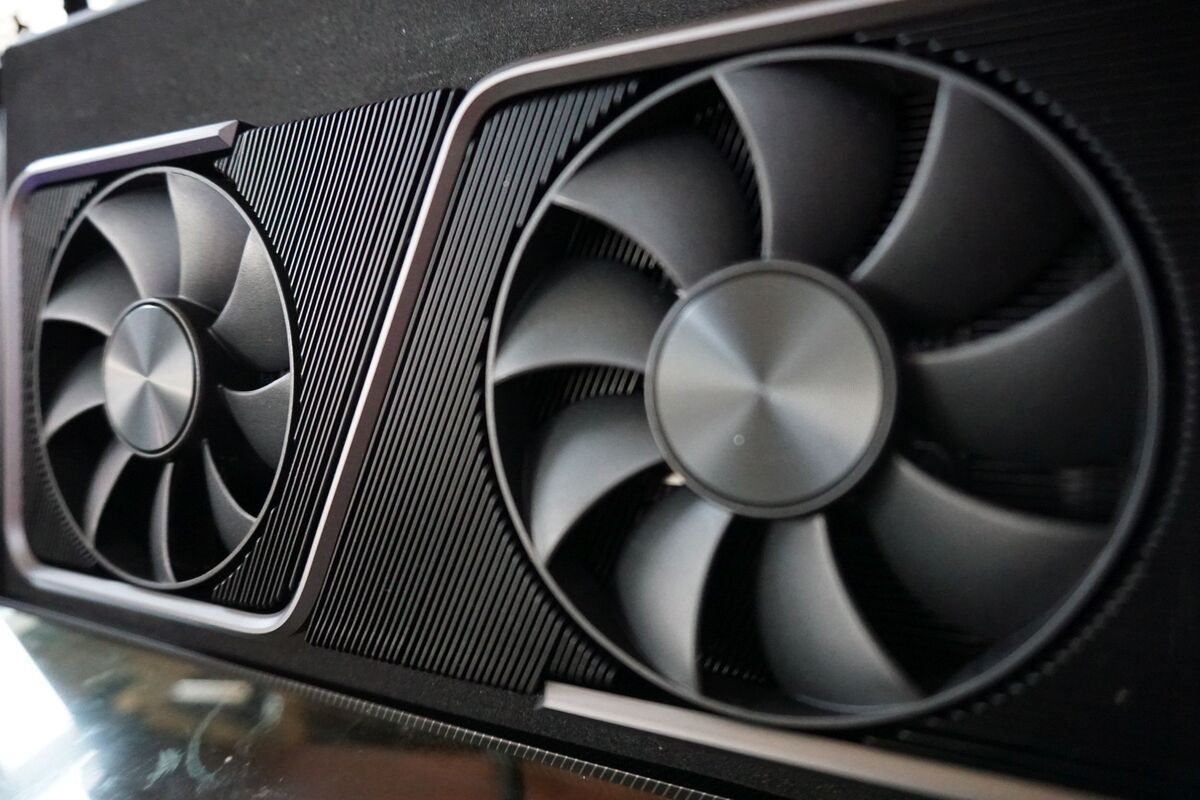 Brad Chacos/IDG
Brad Chacos/IDG
The RTX 3070 Founders Edition still uses thick, black heat fins for most of its construction.
Nvidia’s new generation also upgraded to PCIe 4.0 connectors, which can currently be utilized only on AMD Ryzen systems, though Intel plans to move up from PCIe 3.0 next year. Of course, the card also works with traditional Nvidia features like Shadowplay, NVENC, and one-click game optimization via the GeForce Experience app.
But enough about the features. Let’s get to the games (and a couple of creative workloads, too).
Next page: Our test system, gaming benchmarks begin
Our test system
Our dedicated graphics card test system is a couple of years old, but it’s packed with some of the fastest complementary components available to put any potential performance bottlenecks squarely on the GPU. Most of the hardware was provided by the manufacturers, but we purchased the cooler and storage ourselves.
- Intel Core i7-8700K processor ($300 on Amazon) overclocked to 5GHz all cores
- EVGA CLC 240 closed-loop liquid cooler ($105 on Amazon)
- Asus Maximus X Hero motherboard
- 64GB HyperX Predator RGB DDR4/2933 ($355 on Amazon)
- EVGA 1200W SuperNova P2 power supply ($352 on Amazon)
- Corsair Crystal 570X RGB case, with front and top panels removed and an extra rear fan installed for improved airflow
- 2x 500GB Samsung 860 EVO SSDs ($70 each on Amazon)
We’re comparing the $500 GeForce RTX 3070 Founders Edition against a bunch of other FE cards: Nvidia’s $800 GeForce RTX 3080, $1,200 RTX 2080 Ti, $800 RTX 2080 and the older $700 GTX 1080, as well as the “Super” upgrades for the RTX 2070 and 2080. (MSRPs for the 1080 and 2080 started at $100 less, but Nvidia charged a premium for the FE models.) Because so many owners of the $700 GTX 1080 Ti decided to skip over the lackluster performance increase in the similarly priced RTX 2080, we’re also including the EVGA GTX 1080 Ti SC2 in our roundup. We also included AMD’s $400 Radeon RX 5700 XT, which matched or even beat the RTX 2070’s performance in many games despite starting at $100 less.
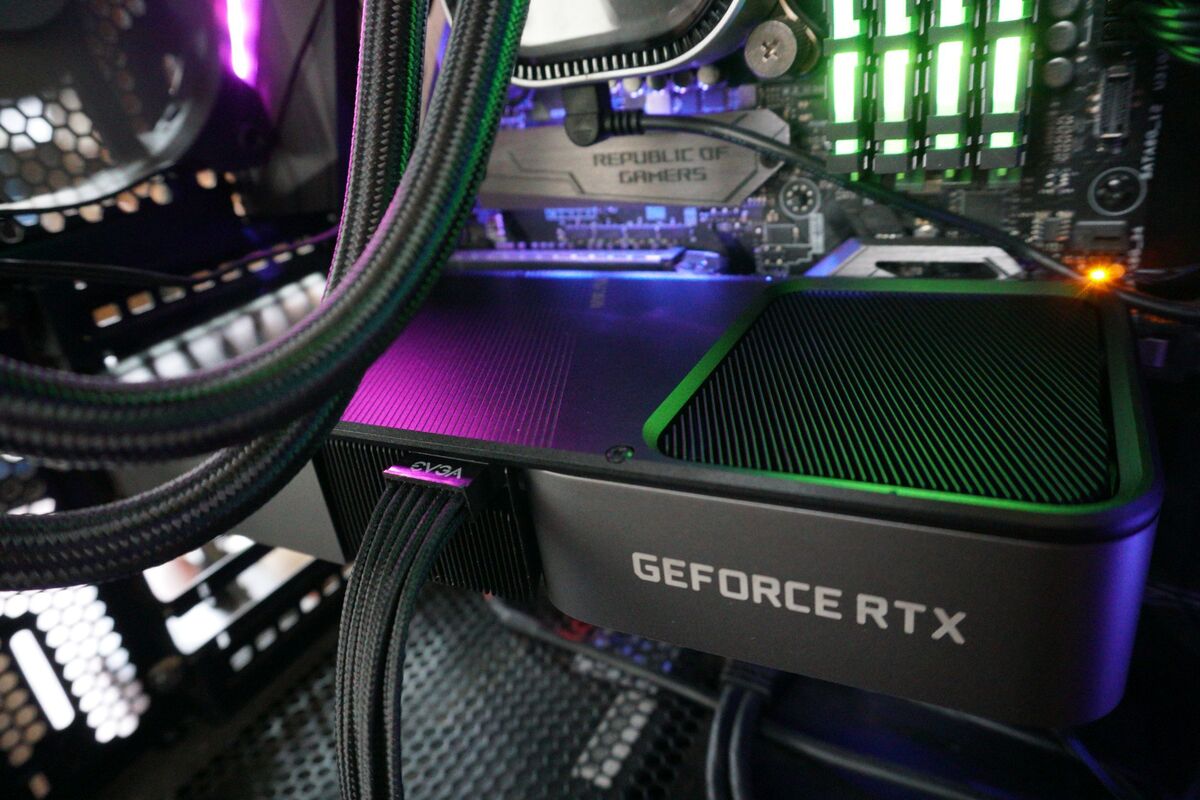 Brad Chacos/IDG
Brad Chacos/IDG
The GeForce RTX 3070 FE in our test system.
We test a variety of games spanning various engines, genres, and graphics APIs (DirectX 11, DX12, and Vulkan). Each game is tested using its in-game benchmark at the highest possible graphics presets unless otherwise noted, with VSync, frame rate caps, real-time ray tracing or DLSS effects, and FreeSync/G-Sync disabled, along with any other vendor-specific technologies like FidelityFX. We’ve also enabled temporal anti-aliasing (TAA) to push these cards to their limits. We run each benchmark at least three times and list the average result for each test.
GeForce RTX 3080 gaming benchmarks
Horizon Zero Dawn
Yep, Sony exclusives are hitting the PC now. Horizon Zero Dawn hit Steam with some performance issues, but the most egregious ones have been mostly cleared up thanks to hard work from the developers, and the game topped the sales charts for weeks after its release. It also seems to respond somewhat to PCIe 4.0 scaling, which will make this an interesting inclusion when we shift to a PCIe 4.0-based system in the future.
Horizon Zero Dawn runs on Guerrilla Games’ Decima engine, the same engine that powers Death Stranding. Ambient Occlusion can still offer iffy results if set to Ultra, so we test with that setting at Medium. Every other visual option is maxed out.
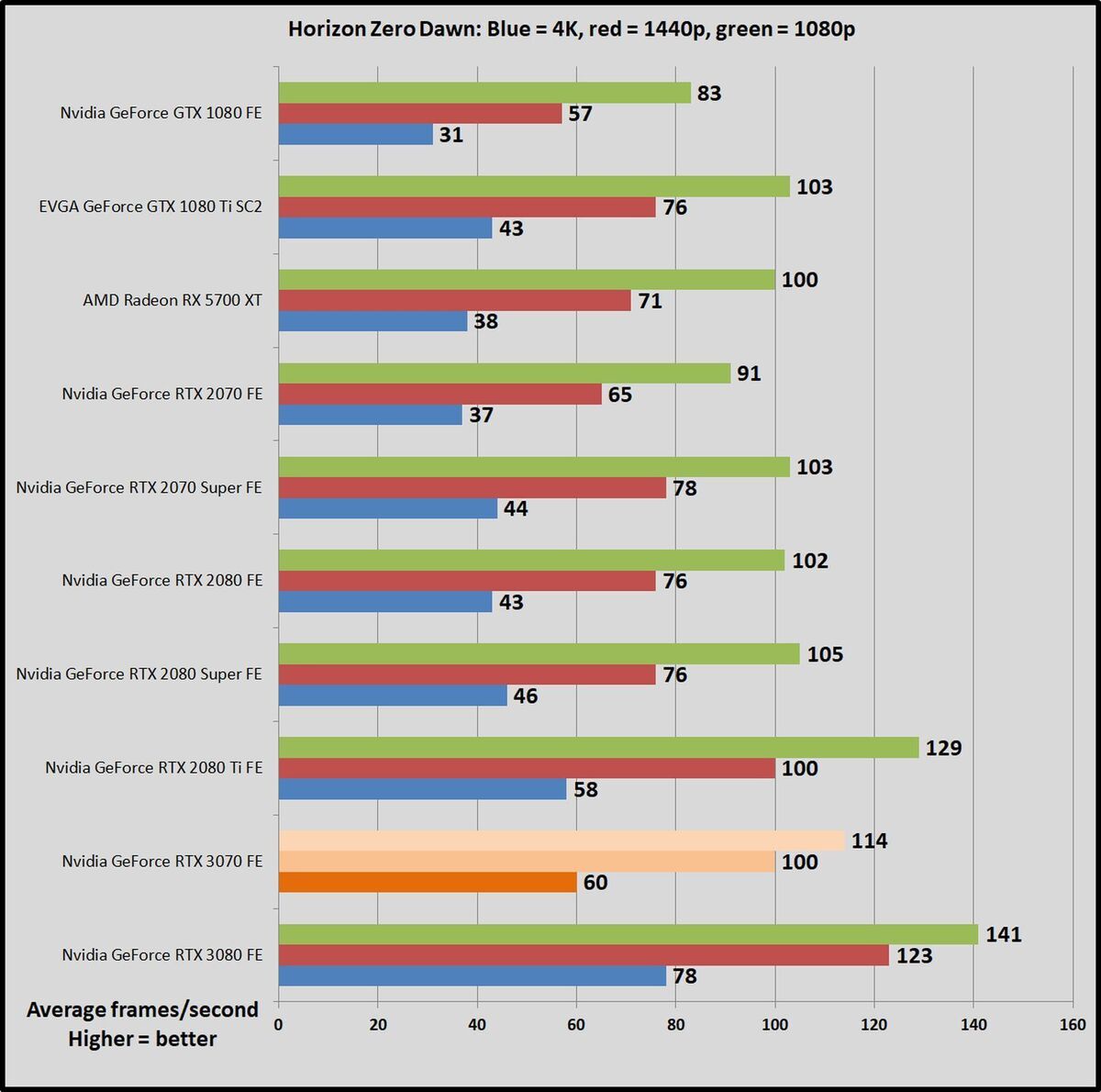 Brad Chacos/IDG
Brad Chacos/IDGThe GeForce RTX 3070 draws equal with the RTX 2080 Ti at both 4K and 1440p resolution. In our RTX 3080 and 3090 reviews, we found that Nvidia’s Ampere architecture doesn’t seem to scale down to lower resolutions as well as older “Turing”-based RTX 20-series options. We see that again with the 1080p results, where the RTX 3070 winds up roughly 12 percent slower than the RTX 2080 Ti.
The less efficient scaling at lower resolutions is also apparent when you compare the RTX 3070 against the RTX 2070 it replaces. The 3070 is 63 percent faster at 4K, but 54 percent faster at 1440p. Regardless, that’s a stellar gen-on-gen leap.
Gears Tactics
Gears Tactics puts it own brutal, fast-paced spin on the XCOM-like genre. This Unreal Engine 4-powered game was built from the ground up for DirectX 12, and we love being able to work a tactics-style game into our benchmarking suite. Better yet, the game comes with a plethora of graphics options for PC snobs. More games should devote such loving care to explaining what flipping all these visual knobs mean. You can’t use the presets to benchmark Gears Tactics, as it intelligently scales to work best on your installed hardware, meaning that “Ultra” on one graphics card can load different settings than “Ultra” on a weaker card. We manually set all options to their highest possible settings.
 Brad Chacos/IDG
Brad Chacos/IDGThe GeForce RTX 3070 winds up a couple of frames behind the RTX 2080 Ti at all resolutions here, but again, it’s effectively a tie. Versus the RTX 2070, the RTX 3070 winds up 69 percent faster at 4K and 52 percent faster at 1440p.
Next page: Gaming benchmarks continue
Wolfenstein: Youngblood
Wolfenstein: Youngblood isn’t the most fun game in the world unless you can play cooperatively with a buddy, but it’s a fearless experiment—and an absolute technical showcase. Running on the Vulkan API, Youngblood achieves blistering frame rates, and it supports all sorts of cutting-edge technologies like ray tracing, DLSS 2.0, HDR, GPU culling, asynchronous computing, and Nvidia’s Content Adaptive Shading. The game includes a built-in benchmark with two different scenes; we tested Lab X.
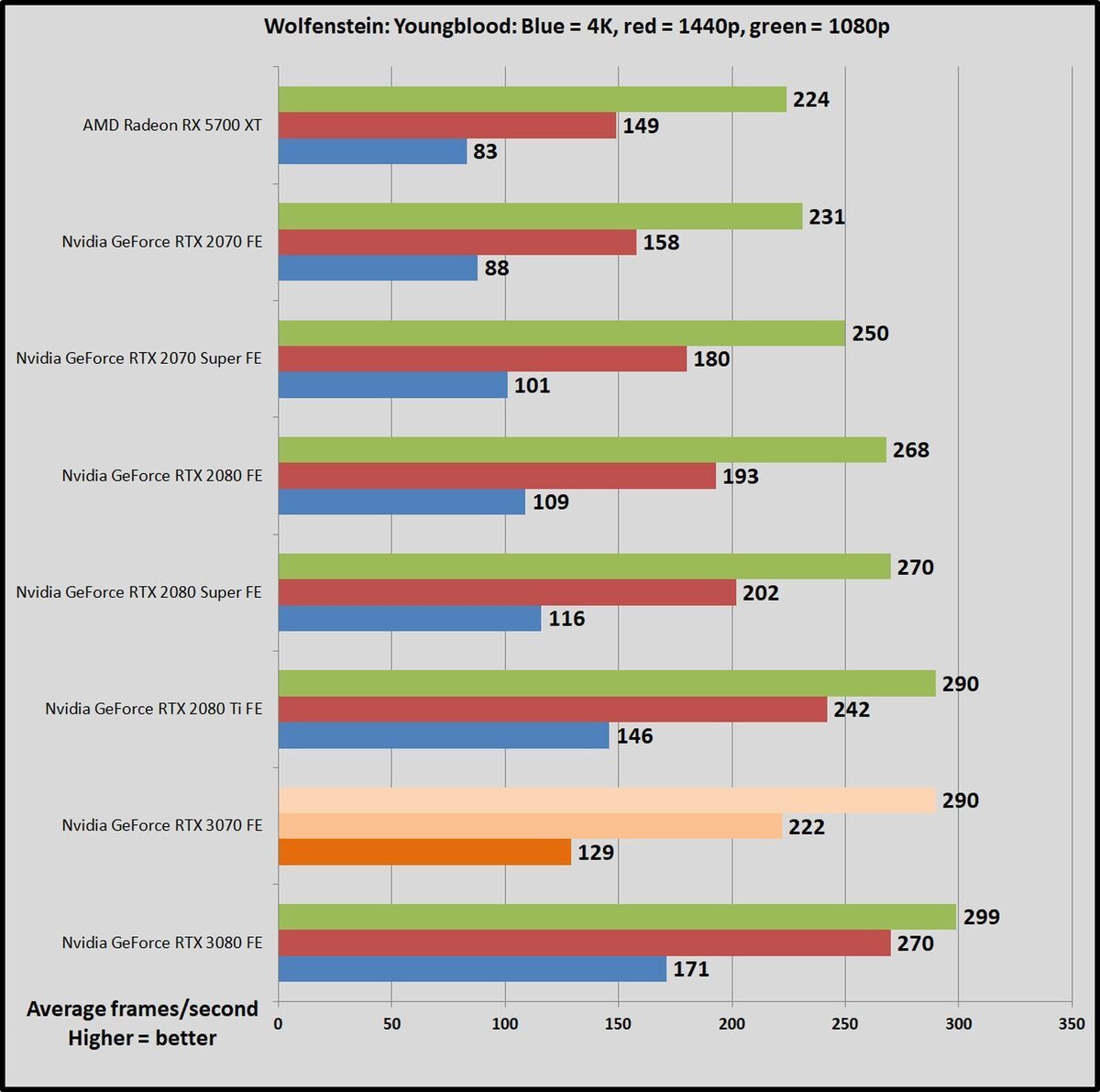 Brad Chacos/IDG
Brad Chacos/IDGThis is the first game that clearly prefers the RTX 2080 Ti’s Turing architecture. Each Turing core has dedicated FP32 and integer pipelines. In Ampere, each core has a dedicated FP32 pipeline, and a second pipeline that can be used for either shading or integer (compute) tasks. That design lets Ampere generally perform better at higher resolutions that can tap those FP32 pipelines more fully. But in games that lean heavily on GPU compute tasks—like Youngblood—it can take some performance off the top, because if the second pipeline is being used to perform integer tasks, it can’t be used for rendering. Or maybe Wolfenstein just prefers the 2080 Ti’s larger 11GB memory buffer.
Either way, the RTX 3070 is 12 percent slower at 4K and 8 percent slower at 1440p, though the cards draw equal at 1080p. It’s worth noting that Wolfenstein hits very, very high frame rates at all three resolutions, though.
Compared to the RTX 2070, the RTX 3070 is 47 percent faster at 4K, and 41 percent faster at 1440p.
Metro Exodus
One of the best games of 2019, Metro Exodus is one of the best-looking games around, too. The latest version of the 4A Engine provides incredibly luscious, ultra-detailed visuals, with one of the most stunning real-time ray tracing implementations released yet. We test in DirectX 12 mode with ray tracing, Hairworks, and DLSS disabled for our basic benchmarks.
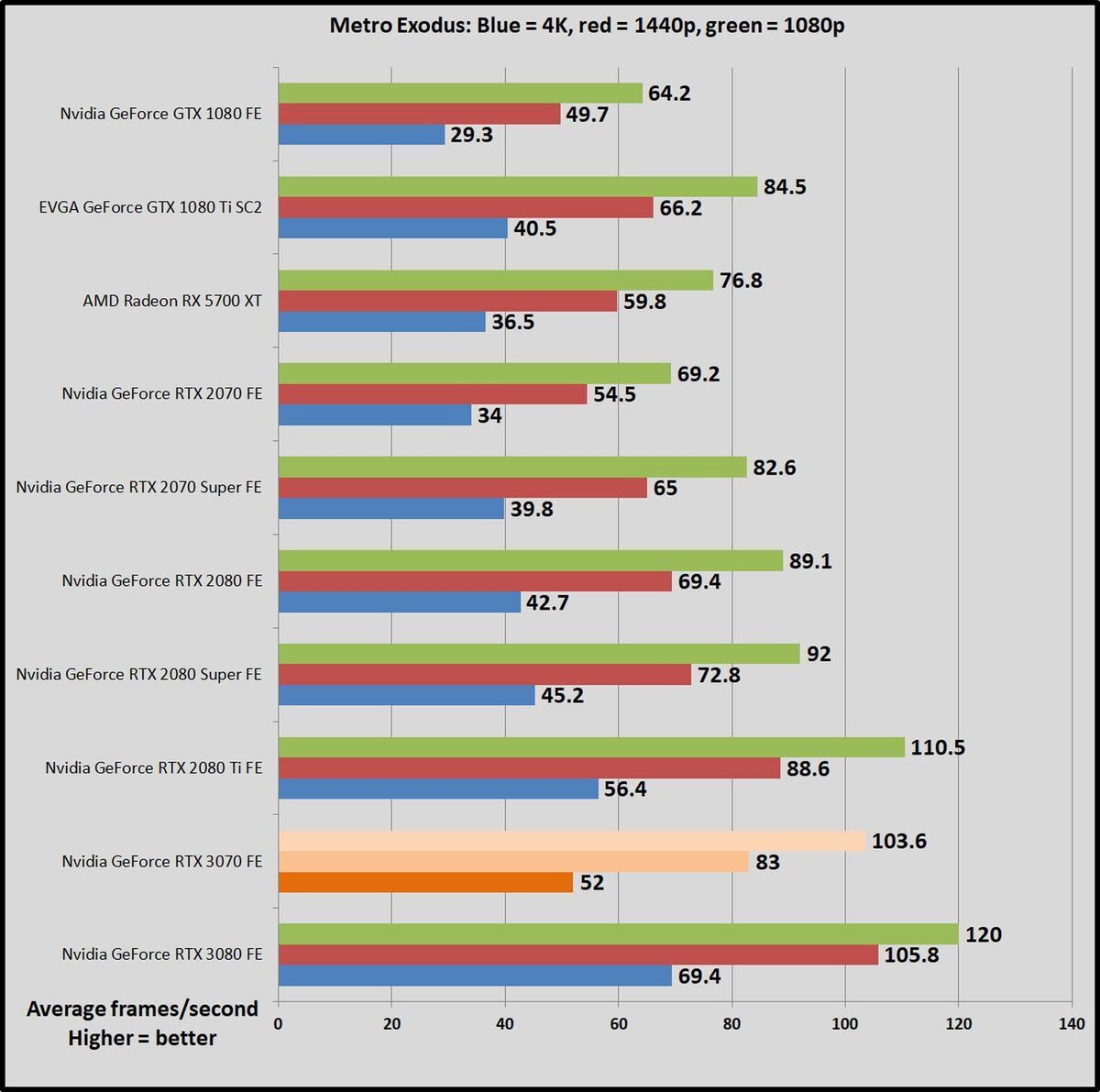 Brad Chacos/IDG
Brad Chacos/IDGAgain, the RTX 3070 can’t quite match the RTX 2080 Ti’s pace here, though it’s effectively identical from a practical standpoint. The 2080 Ti is 8 percent faster at 4K, and 6 percent faster at 1440p and 1080p. That’s only a few frames per second in real life, and your eyes won’t see the difference.
You’ll feel the upgrade from an RTX 2070, though. The RTX 3070 is 53 percent faster at 4K and 1440p resolutions, and 50 percent faster at 1080p. Notably, the RTX 2070 manages 54 frames per second at 1440p, while the RTX 3070 hits 52fps at 4K. That’s a great gen-on-gen upgrade.
Borderlands 3
Borderlands is back! Gearbox’s game defaults to DX12, so we do as well. It gives us a glimpse at the ultra-popular Unreal Engine 4’s performance in a traditional shooter.
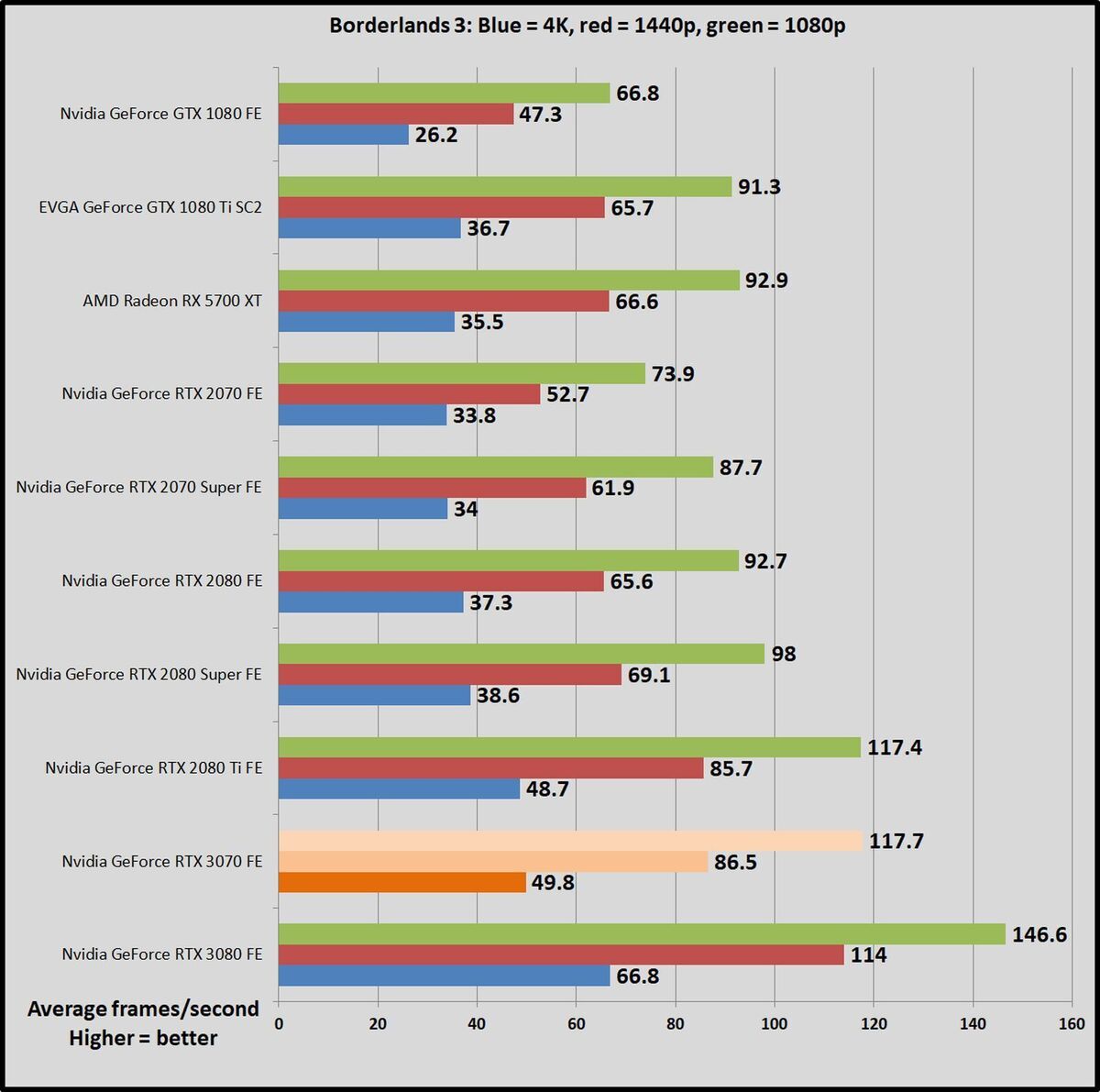 Brad Chacos/IDG
Brad Chacos/IDGThe RTX 3070 indeed bests the 2080 Ti here, though it’s by a scant frame at all three resolutions. You can witness the effect of Ampere and Turing’s different GPU configurations when you compare it against the RTX 2070, though, as this game takes heavy advantage of async compute. Nvidia’s new card is 47 percent faster at 4K, a whopping 64 percent faster at 1440p, and 59 percent faster at 1080p.
Strange Brigade
Strange Brigade is a cooperative third-person shooter where a team of adventurers blasts through hordes of mythological enemies. It’s a technological showcase, built around the next-gen Vulkan and DirectX 12 technologies and infused with features like HDR support and the ability to toggle asynchronous compute on and off. It uses Rebellion’s custom Azure engine. We test using the Vulkan renderer, which is faster than DX12.
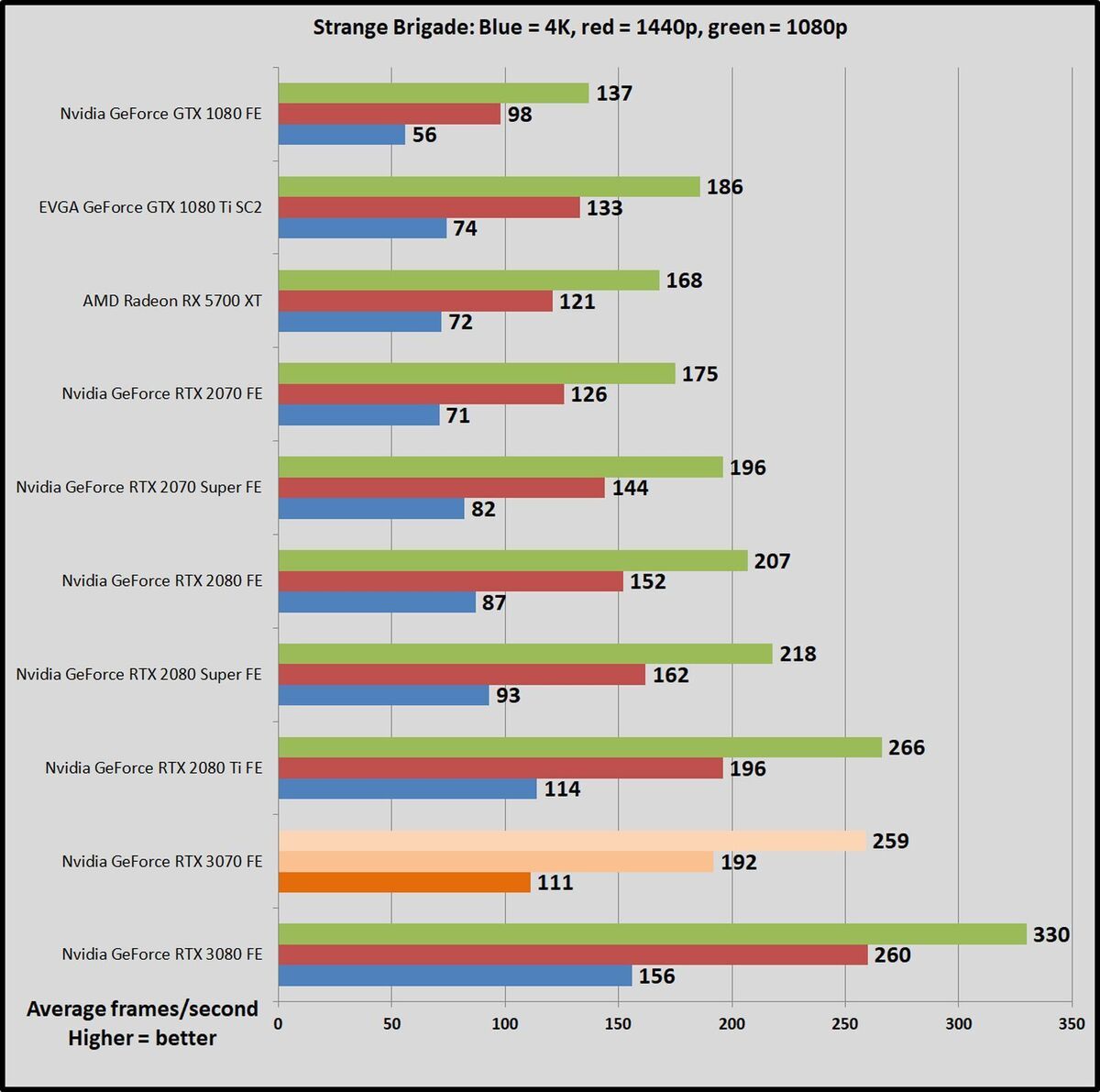 Brad Chacos/IDG
Brad Chacos/IDGThe RTX 3070 is slower than the RTX 2080 Ti here, but only just. It’s 3 percent slower at 4K and 1080p, and 5 percent slower at 1440p. Again, your eyes wouldn’t see the scant few frames separating the two in the real world. Compared to the 2070, the RTX 3070 is 56 percent faster at 4K resolution, 52 percent faster at 1440p, and 48 percent faster at 1080p.
Total War: Troy
The latest game in the popular Total War saga, Troy was given away free for its first 24 hours on the Epic Games Store, moving over 7.5 million copies before it went on proper sale. Total War: Troy is built using a modified version of the Total War: Warhammer 2 engine, and this DX11 title looks stunning for a turn-based strategy game. We test the more intensive battle benchmark.
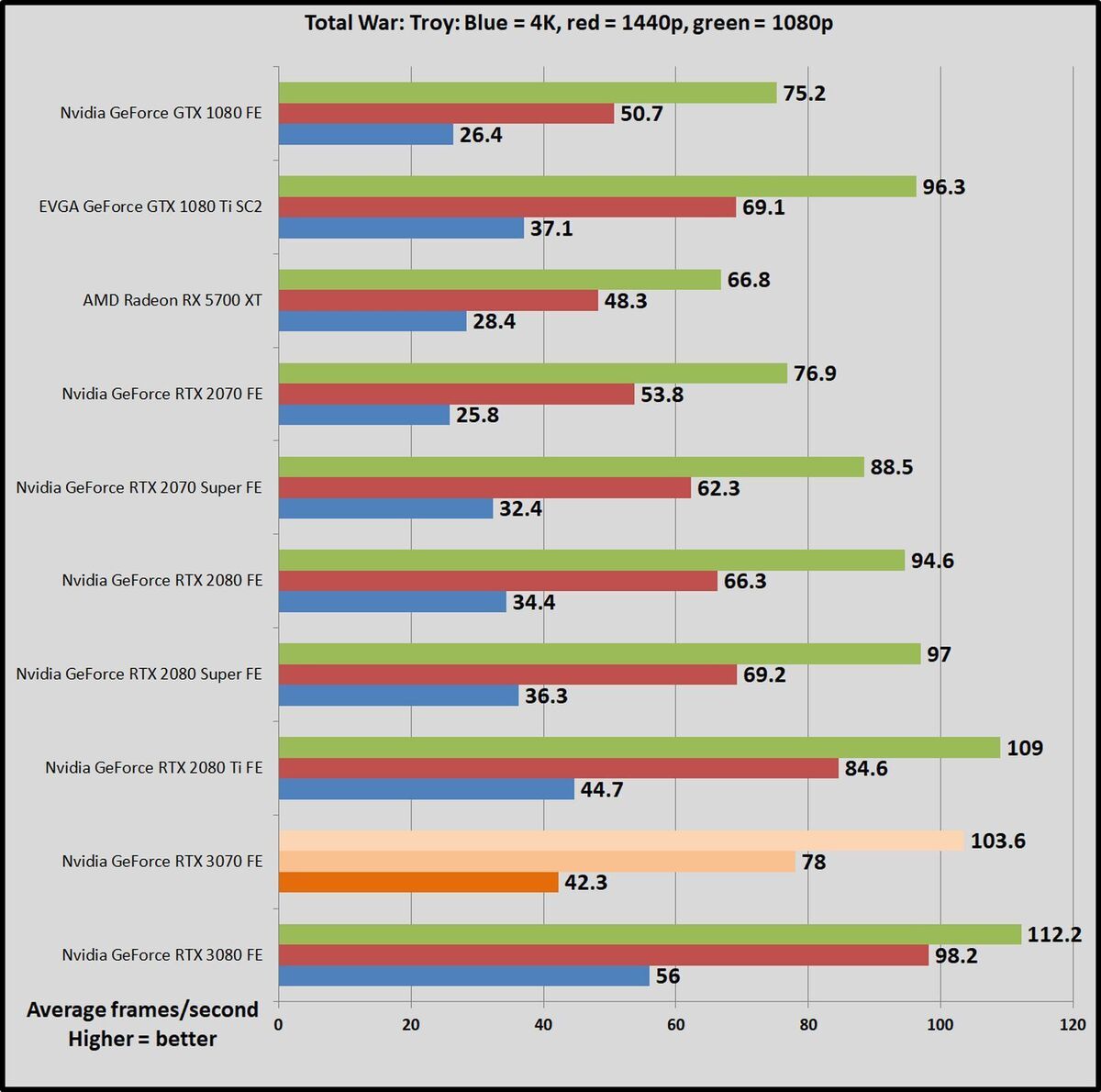 Brad Chacos/IDG
Brad Chacos/IDGOnce again, the RTX 3070 falls behind the RTX 2080 Ti’s pace but delivers the same essential playing experience. It’s 5 percent slower at 4K by the numbers, but in reality, that’s just 2.4 frames per second less in a scenario already running well under the hallowed 60-fps mark. It’s 8 percent slower at 1440p, and 5 percent slower at 1080p.
Next page: Gaming benchmarks continue
F1 2020
The latest in a long line of successful racing games, F1 2020 is a gem to test, supplying a wide array of both graphical and benchmarking options, making it a much more reliable (and fun) option that the Forza series. It’s built on the latest version of Codemasters’ buttery-smooth Ego game engine, complete with support for DX12 and Nvidia’s DLSS technology. We test two laps on the Australia course, with clear skies on and DLSS off.
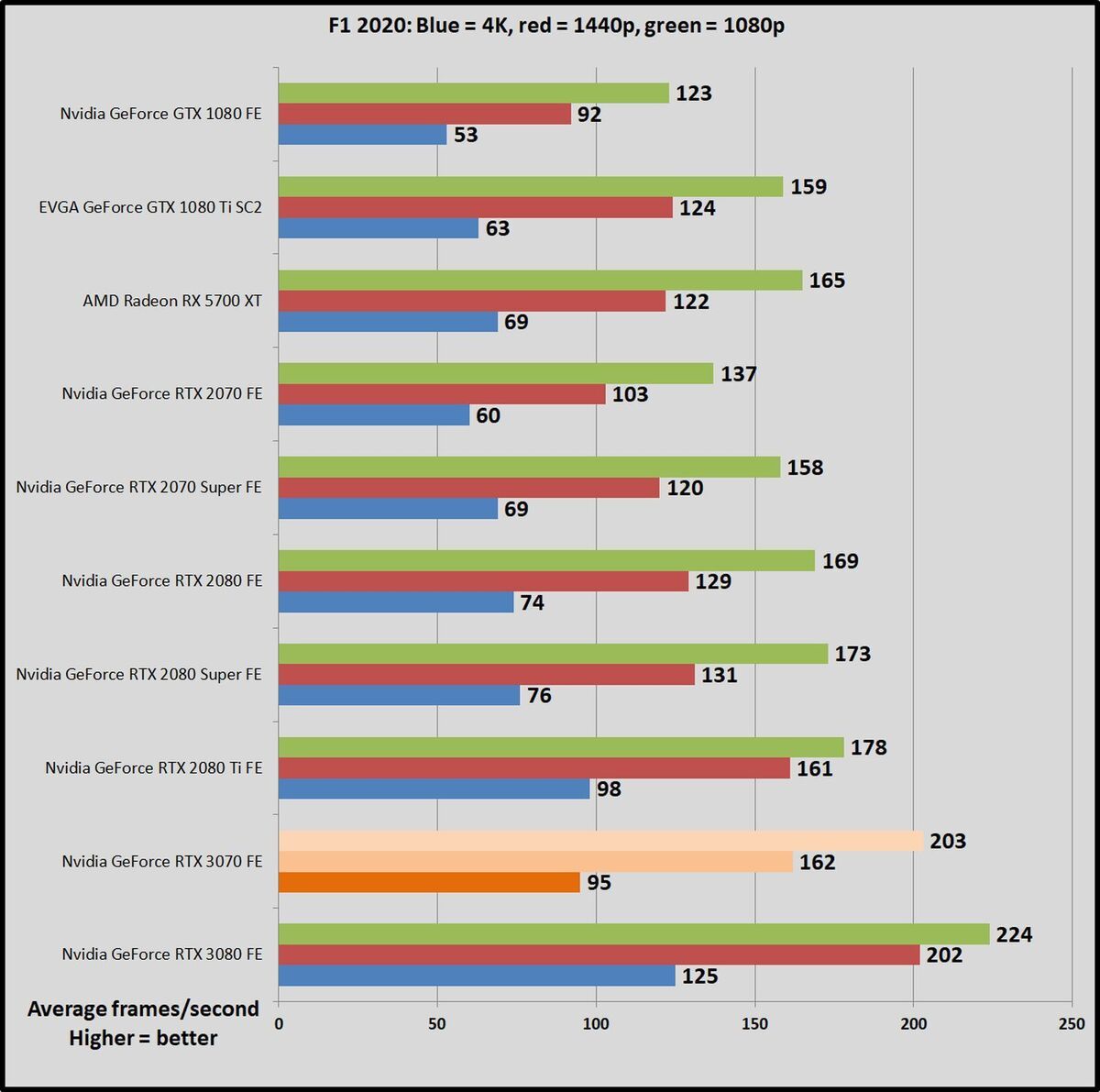 Brad Chacos/IDG
Brad Chacos/IDGHere, the RTX 3070 is 3 percent—and just 3 frames—behind the RTX 2080 Ti at 4K, but the tables turn at 1440p and 1080p. The two cards tie at 1440p, while the RTX 3070 pulls ahead by a full 14 percent at 1080p.
The RTX 2070 is 58 percent slower than the RTX 3070 at 4K and 1440p, and 48 percent slower at 1080p.
Shadow of the Tomb Raider
Shadow of the Tomb Raider concludes the reboot trilogy, and it’s utterly gorgeous. Square Enix optimized this game for DX12, and recommends DX11 only if you’re using older hardware or Windows 7, so we test with DX12. Shadow of the Tomb Raider uses an enhanced version of the Foundation engine that also powered Rise of the Tomb Raider and includes optional real-time ray tracing and DLSS features.
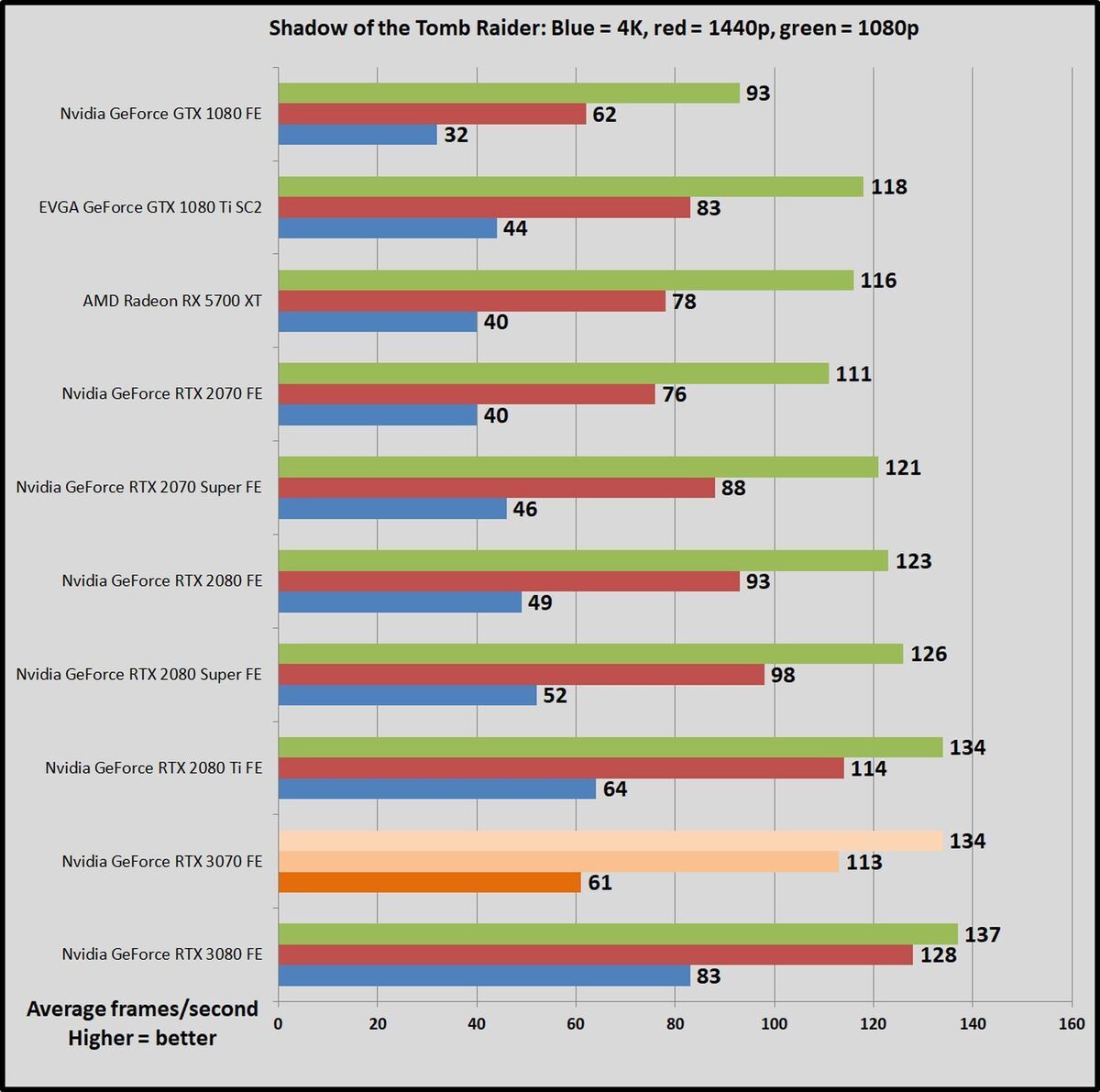 Brad Chacos/IDG
Brad Chacos/IDGThe RTX 3070 is technically slower than the RTX 2080 Ti but it’s a functional tie, with the two cards within 5 percent and a handful of frames of each other.
Nvidia’s new card keeps a large lead over its predecessor. The RTX 3070 is 53 percent faster at 4K, 49 percent faster at 1440p, and 21 percent faster at 1080p than the RTX 2070. The 1080p difference could have been even larger, but the RTX 3070 is bumping against the upper limits of the game engine, which won’t push much beyond 135 fps on our system in any circumstance.
Grand Theft Auto V
This DX11 game isn’t really a visual barn-burner like the (somewhat wonky) Red Dead Redemption 2, but it still tops the Steam charts day in and day out, so we deem it more worthy of testing. RDR2 will melt your graphics card, sure, but GTA V remains so popular years after launch that upgraded versions of it will be available on the next-generation consoles. That’s staying power.
We test Grand Theft Auto V with all options turned to Very High, all Advanced Graphics options except extended shadows enabled, and FXAA. GTA V runs on the RAGE engine and has received substantial updates since its initial launch.
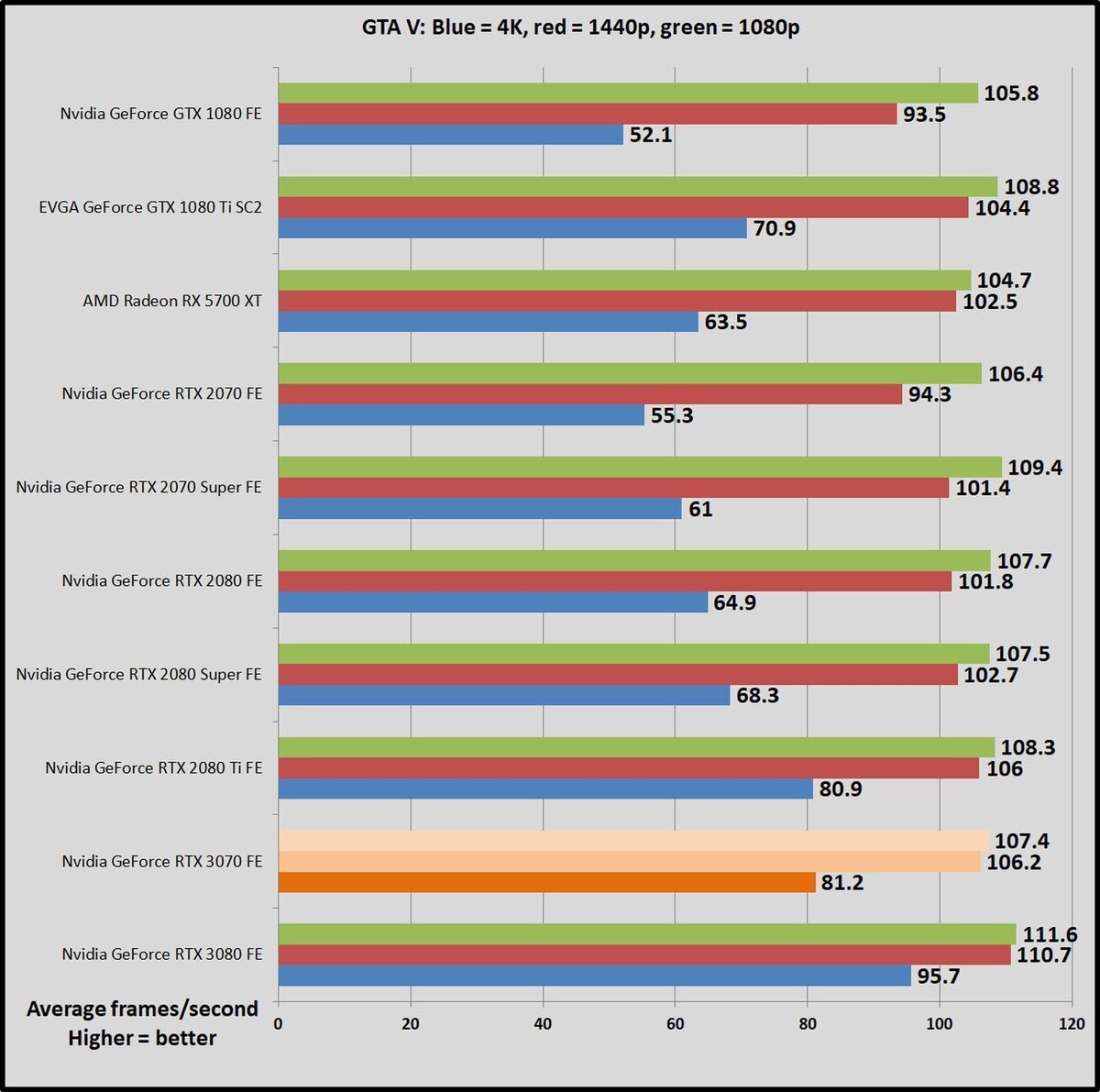 Brad Chacos/IDG
Brad Chacos/IDGLike in Borderlands, the RTX 3070 technically wins here, but it’s a functional tie, with only a frame or so’s difference between all three major resolutions. At 1440p and 1080p, all of the high-end cards are pushing GTA V as fast as it can go, so the 4K results show the most separation. Versus the RTX 2070, the RTX 3070 is 47 percent faster at 4K and 13 percent faster at 1440p.
Rainbow Six Siege
Like GTA V, Ubisoft’s Rainbow Six Siege still dominates the Steam charts years after its launch, and it’ll be getting a visual upgrade for the next-gen consoles. The developers have poured a ton of work into the game’s AnvilNext engine over the years, eventually rolling out a Vulkan version of the game that we use to test. By default, the game lowers the render scaling to increase frame rates, but we set it to 100 percent to benchmark native rendering performance on graphics cards. Even still, frame rates soar.
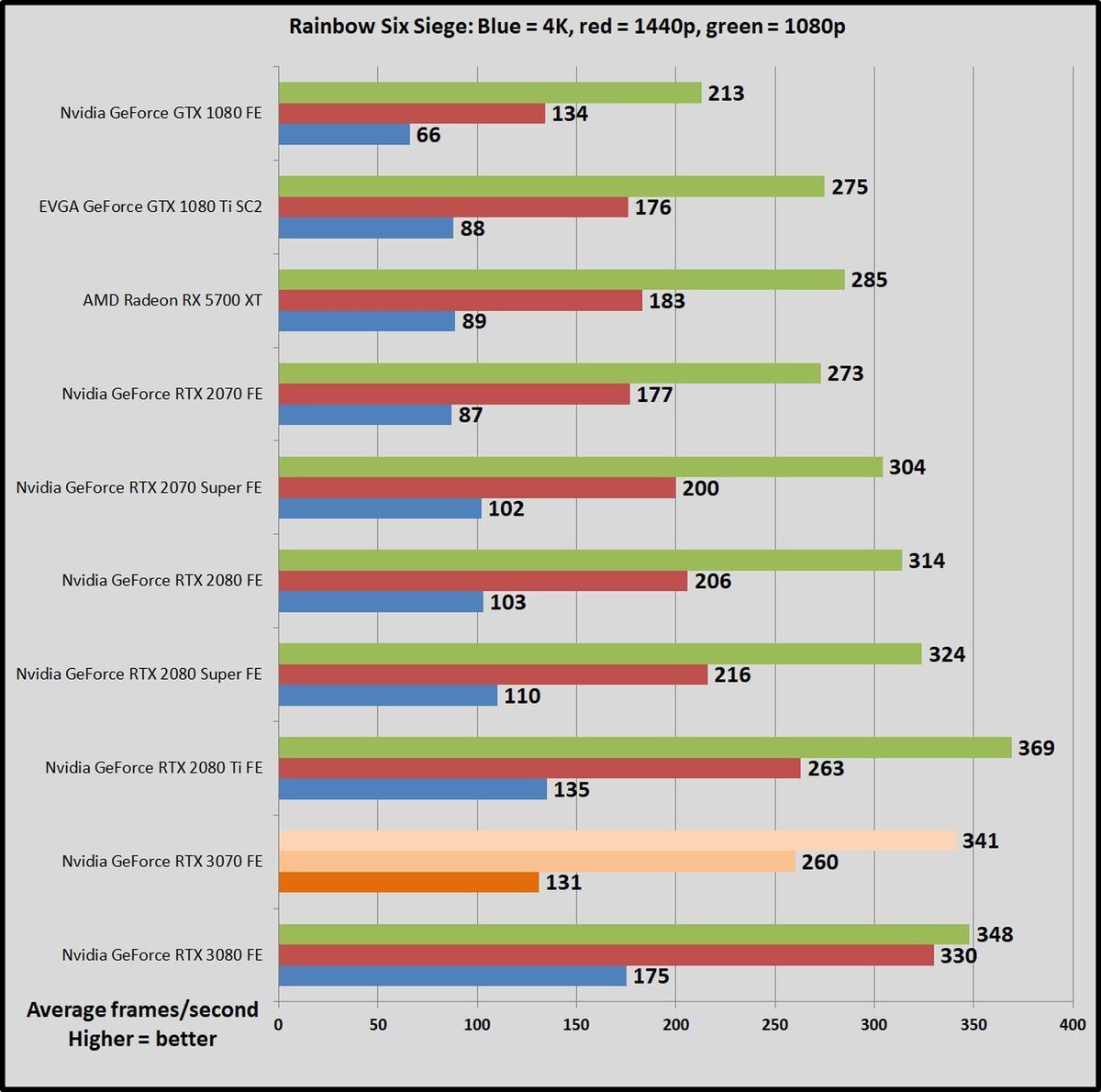 Brad Chacos/IDG
Brad Chacos/IDGThe RTX 3070 falls a few frames behind the RTX 2080 Ti at 4K and 1440p, but both cards deliver functionally the same results. The RTX 2080 Ti pulls ahead a bit more at 1080p, where it’s 8 percent faster.
Nvidia’s new card is 51 percent faster than the RTX 2070 at 4K, 47 percent faster at 1440p, and 25 percent faster at 1080p.
That’s it for traditional gaming benchmarks. Now let’s take a peek at how the GeForce RTX 3070 performs with real time ray tracing enabled.
Next page: RTX 3070 ray tracing performance
GeForce RTX 3070 ray tracing performance
The Ampere GPUs inside Nvidia’s GeForce RTX 30-series graphics cards include upgraded versions of the dedicated RT and tensor cores that debuted in the RTX 20-series, helping them process ray tracing faster and enable Deep Learning Super Sampling (DLSS).
We’ve already determined in our RTX 3080 review that the upgraded hardware doesn’t make ray tracing more efficient in games that only activate one or two ray tracing effects, like the titles benchmarked below. You should see bigger differences in games that more fully embrace the technology, like Minecraft RTX and Quake II RTX, which are fully path-traced, and the upcoming Cyberpunk 2077, which supports a wide range of ray tracing effects.
Nonetheless, we feel it’s useful to benchmark these titles to see what you can expect by turning on ray tracing and DLSS. Even with DLSS on, activating ray tracing sent most RTX 20-series graphics cards to their knees, but the raw firepower of Ampere helps the RTX 30-series maintain more playable frame rates at higher resolutions. Ray tracing may not be more efficient in these titles compared to the RTX 20-series, but the Ampere GPUs are pumping out frames so fast, it’s a lot easier to hit 60 fps-plus with all the eye candy cranked up. For more information about ray tracing and DLSS, check out our Nvidia RTX retrospective from the end of the RTX 20-series’ lifespan.
We test these games using the same settings discussed in the previous section, but with DLSS enabled and all ray tracing options cranked to Ultra. We’ll include two charts. The first shows standard performance with ray tracing disabled, while the second shows results with ray tracing active, so you can also see the performance impact imparted by flipping it on.
First up: Metro Exodus, which includes ray-traced Global Illumination and the first-gen DLSS technology.
 Brad Chacos/IDG
Brad Chacos/IDG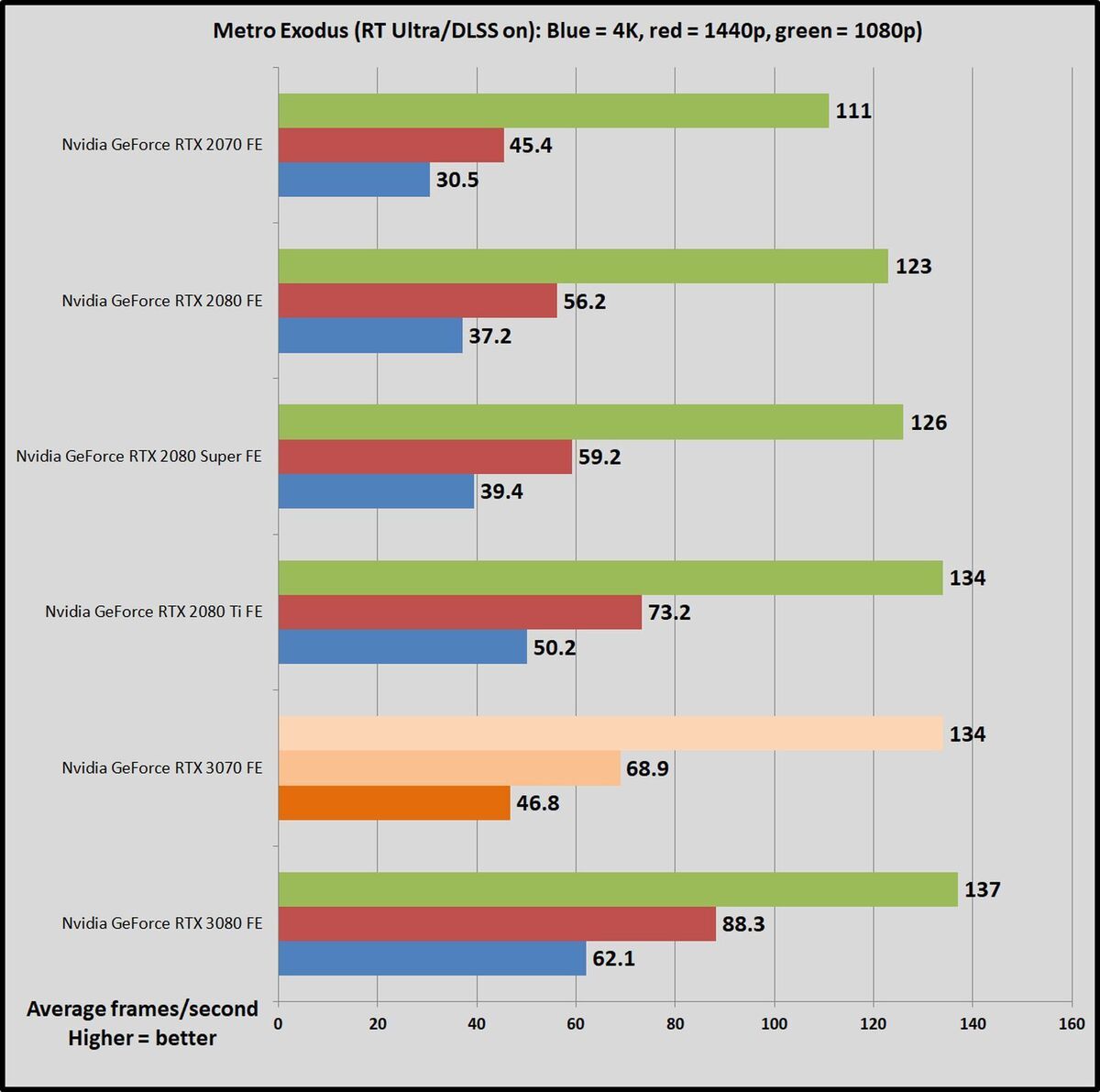 Brad Chacos/IDG
Brad Chacos/IDGThe RTX 3070 can’t quite match the RTX 2080 Ti’s pace with ray tracing and DLSS off, so it’s no surprise to see it lagging slightly behind here. But the more practical takeaway is that even with ray tracing and all visual options cranked to the max, you can still get very playable experiences at 1440p and 1080p resolution. Nvidia’s former $500 option, the RTX 2070, was significantly slower with ray tracing enabled, and could basically only deliver a smooth 60 at 1080p resolution.
Both the RTX 3070 and 2080 Ti fall behind the 60-fps mark at 4K resolution with ray tracing enabled, but 45 to 50 frames per second isn’t terrible in this slower-paced shooting adventure, especially if you have an adaptive-sync (G-Sync or FreeSync) display to help smooth things out.
Shadow of the Tomb Raider was one of the first games to support Nvidia’s RTX endeavors. It includes ray-traced shadows and DLSS 1.0. This game doesn’t let you play at 1080p with DLSS 1.0 on, so you won’t see those results here.
 Brad Chacos/IDG
Brad Chacos/IDG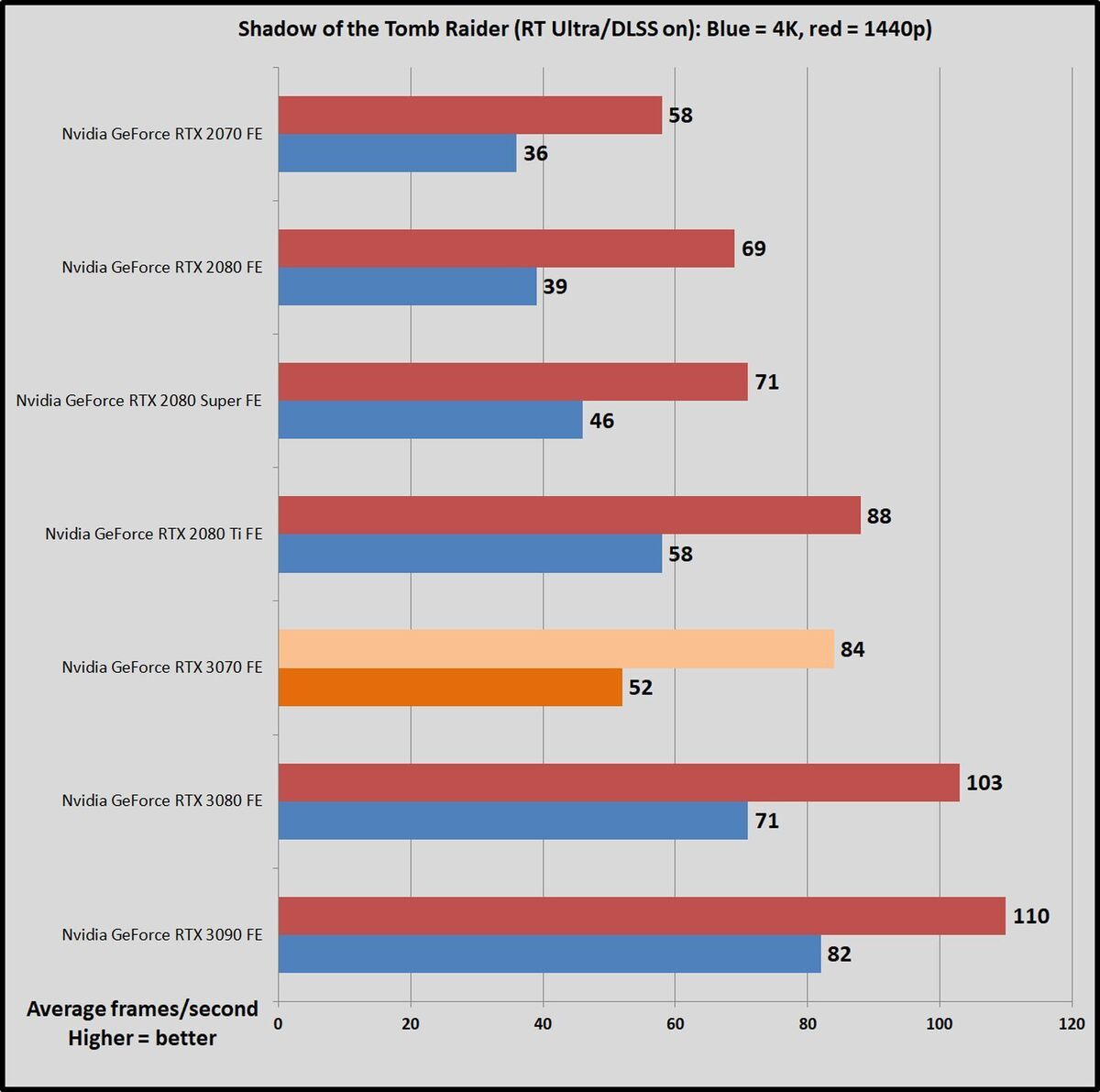 Brad Chacos/IDG
Brad Chacos/IDGThe older RTX 2070 couldn’t get to 60 fps in any situation with ray tracing turned to ultra, even with DLSS enabled. The RTX 3070 far exceeds that mark at 1080p, and comes within spitting distance at 1440p. Given the slower nature of this adventure game, the RTX 3070 and RTX 2080 Ti’s results are definitely playable at 1440p. The RTX 3070 is a bit slower than the RTX 2080 Ti, just like it is with ray tracing off, but turning on the strenuous lighting effect amplifies the difference.
Wolfenstein Youngblood includes ray-traced reflections, as well as Nvidia’s faster, better DLSS 2.0 technology that will be powering the next generation of RTX-enabled games. We’re only including 4K results here, as at lower resolutions, enabling ray tracing wound up delivering a hard, uniform 135-fps cap across these cards. We’re still investigating why that is, but 4K resolution is strenuous enough to show performance differences.
 Brad Chacos/IDG
Brad Chacos/IDG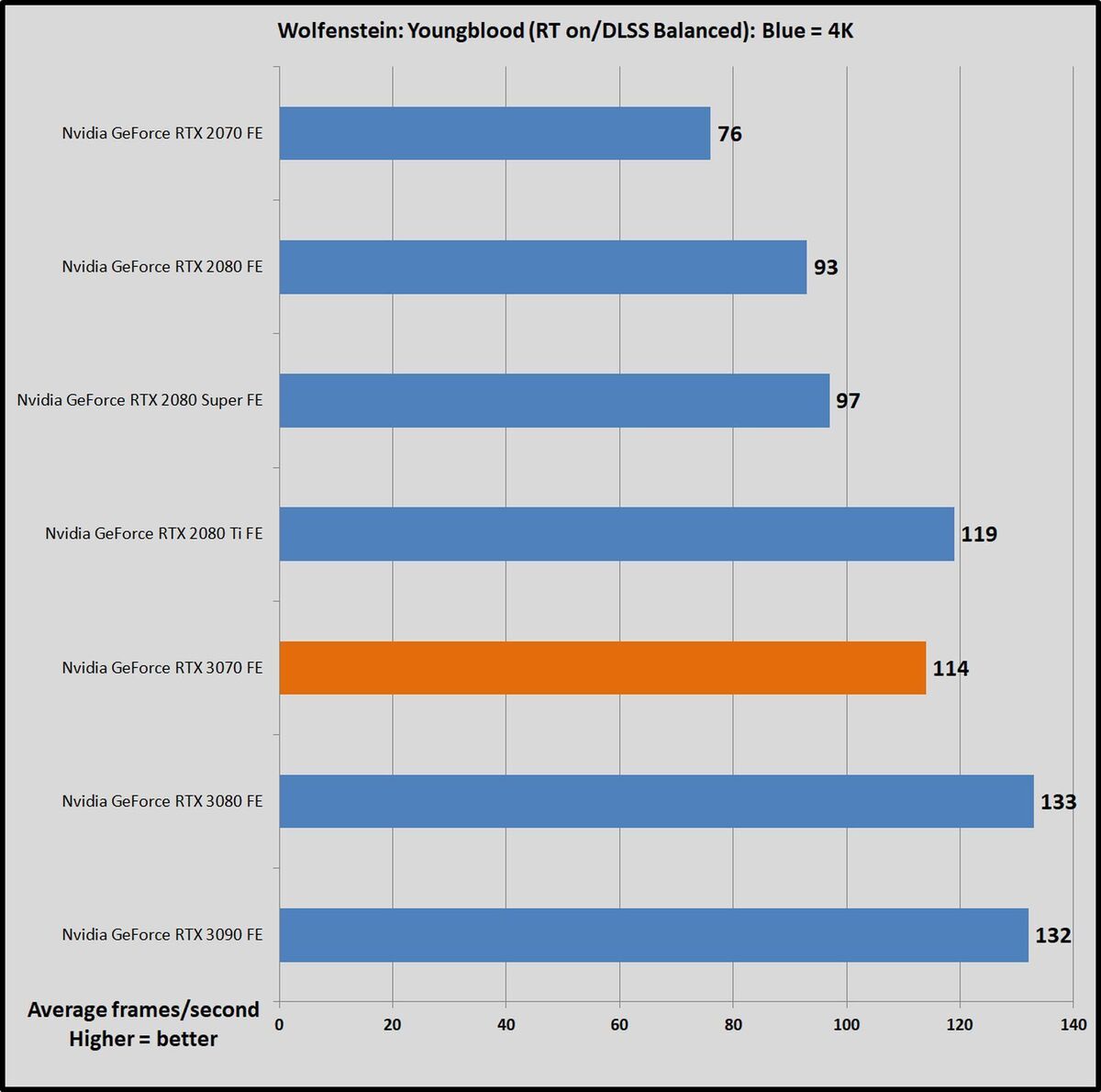 Brad Chacos/IDG
Brad Chacos/IDGAs you can see, turning on ray tracing with DLSS 2.0 doesn’t result in a major performance impact, and the RTX 3070 and 2080 Ti once again deliver similar results. Ray tracing and the ability to push a 4K, 120Hz monitor to its fullest? Yes please. Again, though, note the performance change generation over generation. The RTX 3070 is 50 percent faster than the RTX 2070 with ray tracing on.
But you don’t need to have ray tracing turned on to get DLSS 2.0’s delicious performance-boosting benefits. F1 2020 supports DLSS 2.0 but not ray tracing, and activating it (as an antialiasing option) delivers a healthy speed bump with no noticeable visual downgrades.
 Brad Chacos/IDG
Brad Chacos/IDG Brad Chacos/IDG
Brad Chacos/IDGOnce again, the RTX 3070 and RTX 2080 Ti are in a dead heat, while Nvidia’s new card winds up a whopping 50 percent faster than its RTX 2070 predecessor.
Bottom line? The $500 RTX 3070 lets you play ray traced games at playable frame rates at 1440p, and sometimes at 4K if you don’t mind falling slightly below 60 fps, or tinkering with some graphics settings. You couldn’t say that about the RTX 2070, nor most of the RTX 20-series lineup.
Next page: Creative benchmarks
Creative benchmarks
After witnessing how well Ampere performed in creative tasks versus Turing as part of our GeForce RTX 3090 review, we decided to test a few content creation benchmarks on the RTX 3070, too. Full-time creators would probably be better off investing in a more powerful GPU with more memory capacity and drivers optimized around professional applications, but if you want to do some video rendering on the side of your gaming, the RTX 3070 often tramples over the RTX 2080 Ti thanks to Ampere’s improved RT and tensor cores. Using the RT cores for motion blur acceleration isn’t a big deal in gaming (yet, at least), but it can make a world of difference in some creative workloads.
We’ve only recently started testing some creative workloads, so you won’t find the RTX 2070 compared here, nor many other GPUs. But these should show how the RTX 3070 stacks up against previous-gen flagships, including the RTX 2080 Ti and GTX 1080 Ti.
Let’s quickly start with Geekbench 5. This quick cross-platform benchmark measures GPU compute performance “using workloads that include image processing, computational photography, computer vision, and machine learning.” The app supports OpenCL and CUDA. Any GPU can run OpenCL, but CUDA requires specialized hardware and software from Nvidia, and delivers faster performance. We’ve focused on CUDA results here, so you’ll only see Nvidia GPUs compared.
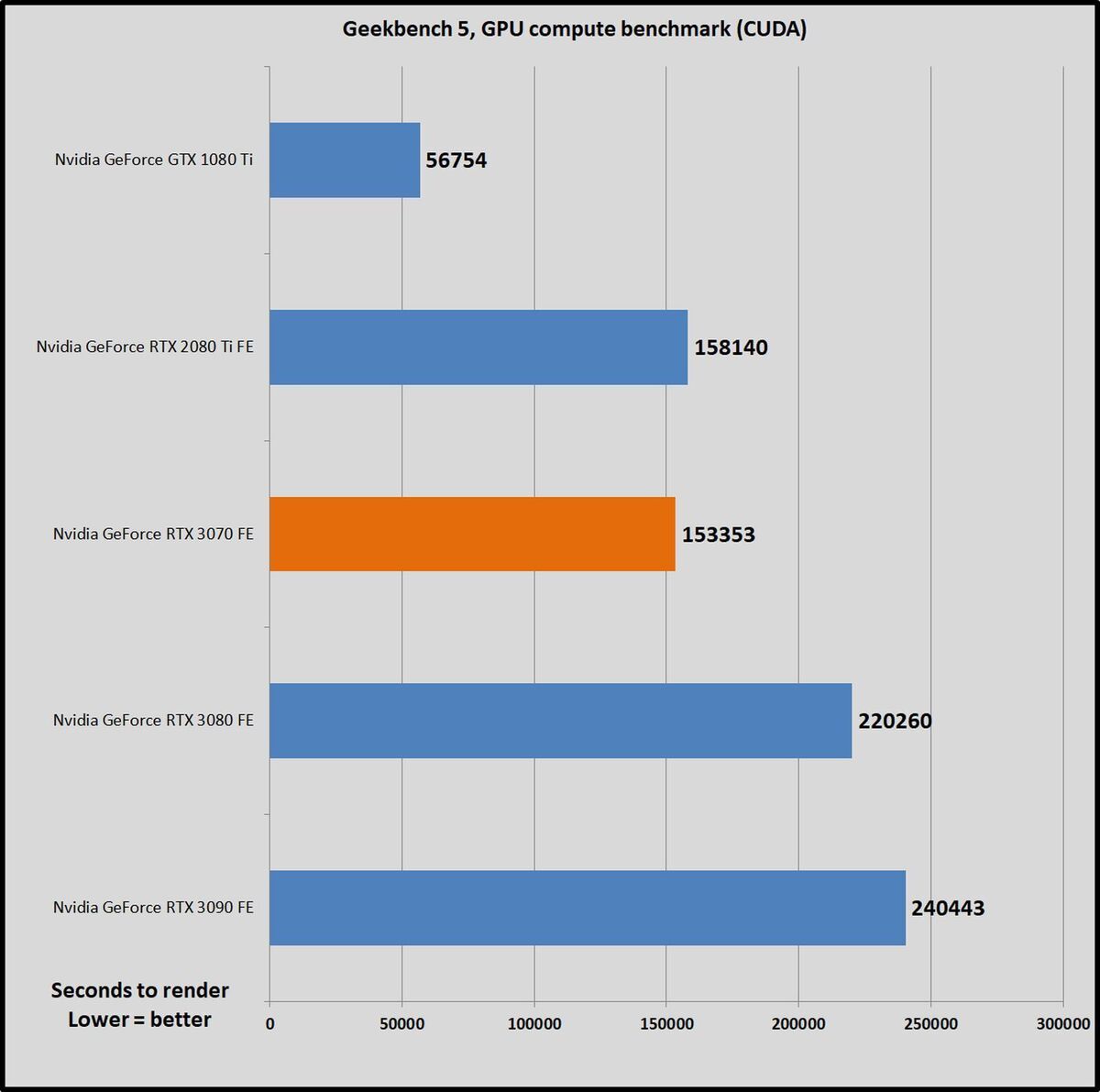 Brad Chacos/IDG
Brad Chacos/IDGThe RTX 3070 is just behind the RTX 2080 Ti, but only barely. Let’s move on to more practical rendering benchmarks.
Luxmark 3.1 is a pure OpenCL benchmark based on the LuxRender v1.5 engine. It offers three different scenes to test. The “simple” Luxball HDR renders 217K triangles; the “medium” Neumann TLM-102 Special Edition renders 1769K triangles; and the “complex” Hotel Lobby renders 4973K triangles. Higher scores are better.
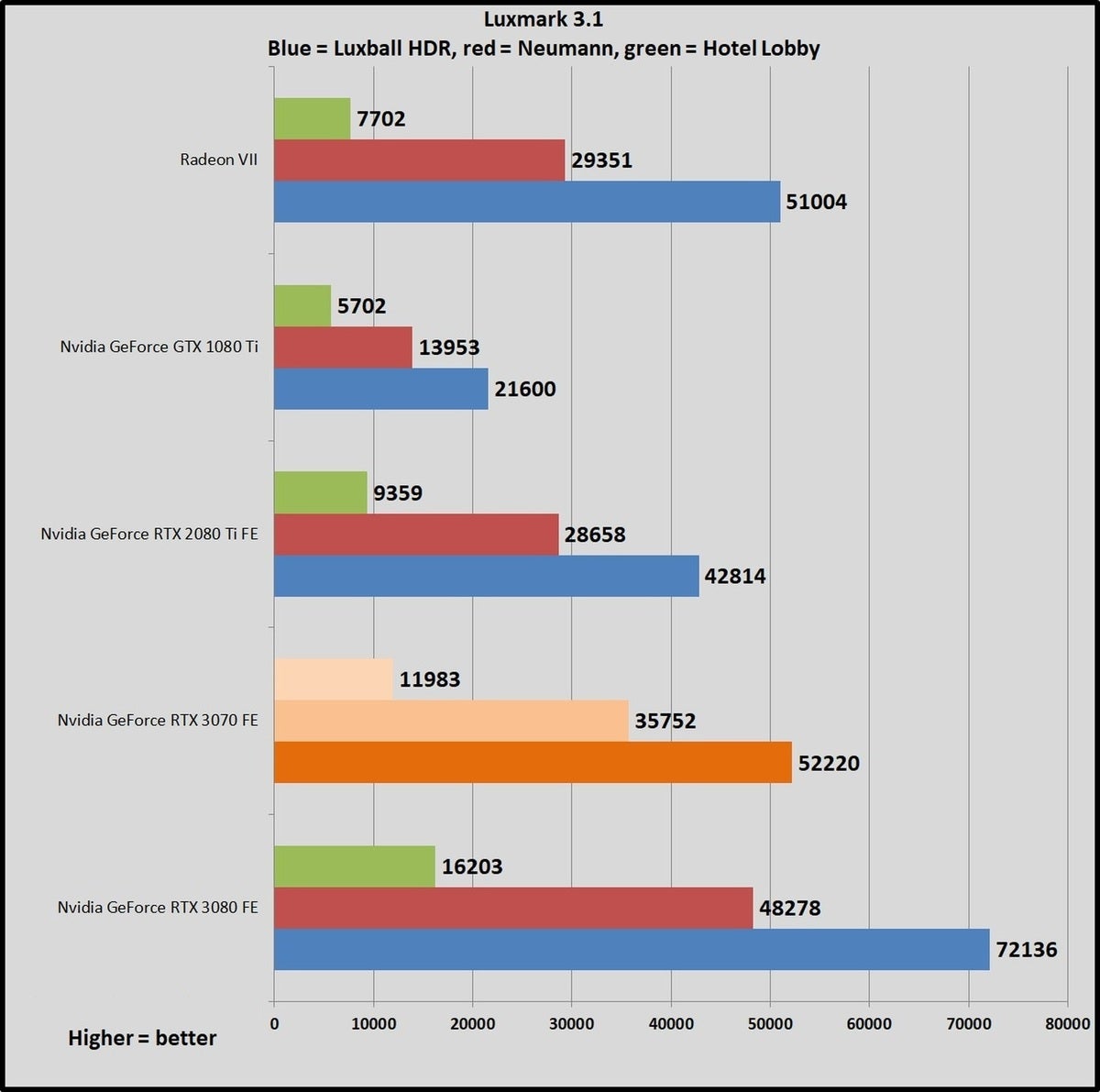 Brad Chacos/IDG
Brad Chacos/IDGThe $700 RTX 3080 stands head and shoulders above the others, but the RTX 3070 pulls ahead of the RTX 2080 Ti by a notable margin.
Nvidia’s software stack is a key ace in the hole. Many developers swear by CUDA software optimizations, and now that RTX is here, Nvidia’s been rolling out “OptiX” technology that leverages all those RT and tensor cores for creative purposes. Blender is a very popular free and open-source 3D graphics program used to create visual effects and even full-blown movies. In 2019, Blender integrated Nvidia OptiX into Cycles, its physically based path tracer for production rendering, to tap into GeForce’s RT cores for hardware-accelerated ray tracing.
We tested Blender using the Blender Open Toolkit. We tested two scenes: Classroom and Victor, with the latter being the most strenuous scene the benchmark offers. AMD’s Radeon VII consistently crashed when trying to run Victor, but worked fine with Classroom. We tested each graphics card with the best-performing GPU acceleration possible for that card. That’s OpenCL for the Radeon VII, CUDA for the GTX 1080 Ti, and OptiX for the GeForce RTX cards. The results show total rendering time, so lower is better.
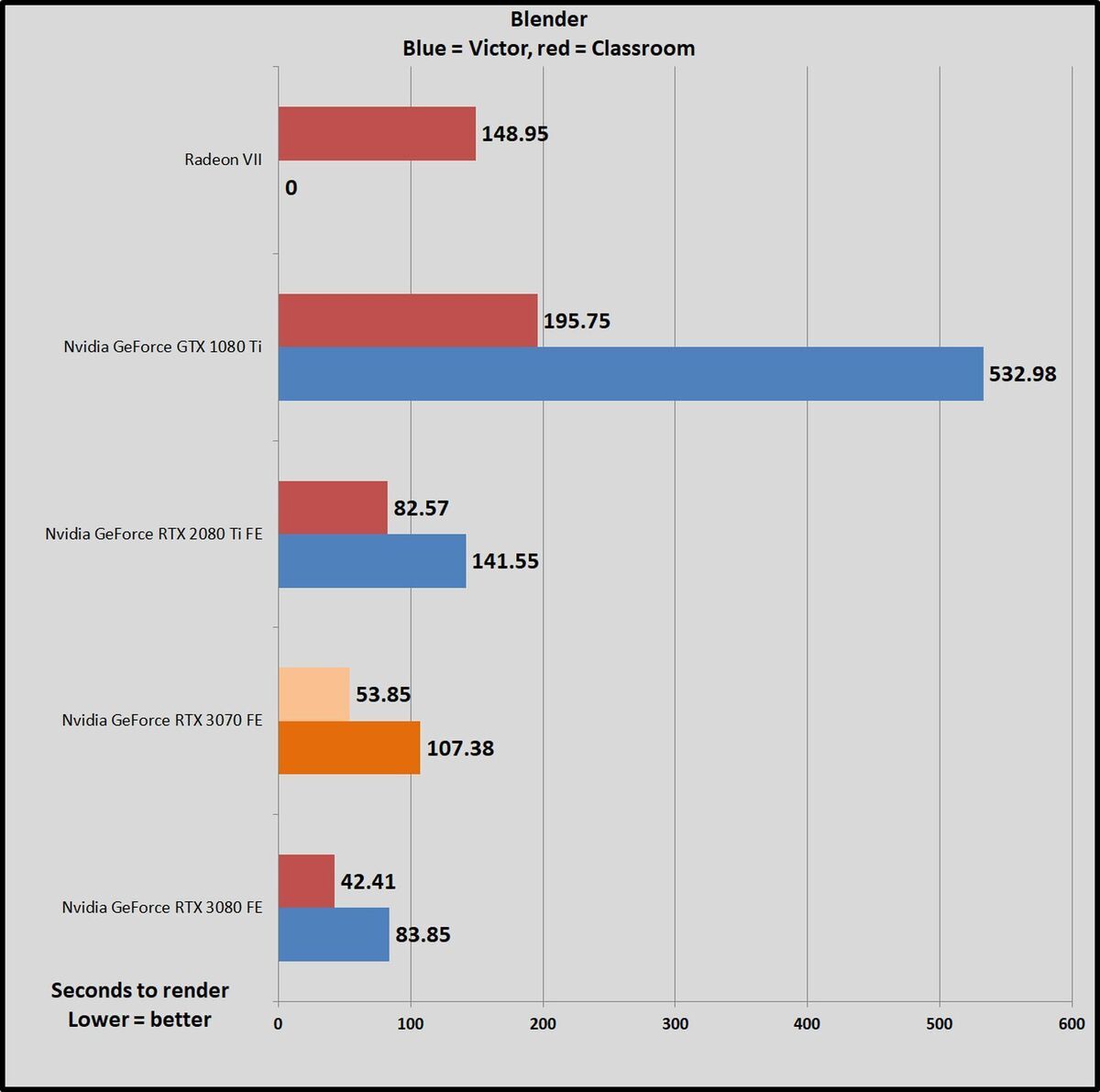 Brad Chacos/IDG
Brad Chacos/IDGOnce again, the RTX 3070 finishes its tasks at a much faster clip than the RTX 2080 Ti. The advanced motion blur acceleration inside Ampere is pulling its weight here. If you render 4K or 8K videos, though, the larger 11GB memory capacity of the RTX 2080 Ti might wind up more useful than the faster render times provided by the 8GB RTX 3070.
OctaneBench 2020 v1.5. is a canned test offered by OTOY to benchmark your system’s performance with the company’s OctaneRender, an unbiased, spectrally correct GPU engine. OctaneBench (and OctaneRender) also integrate Nvidia’s OptiX API for accelerated ray tracing performance on GPUs that support it. The RTX cards do; the GTX 1080 Ti again sticks to CUDA. The benchmark spits out a final score after rendering several scenes, and the higher it is, the better your GPU performs. OctaneRender requires CUDA or Optix, so again, you won’t find the Radeon VII here.
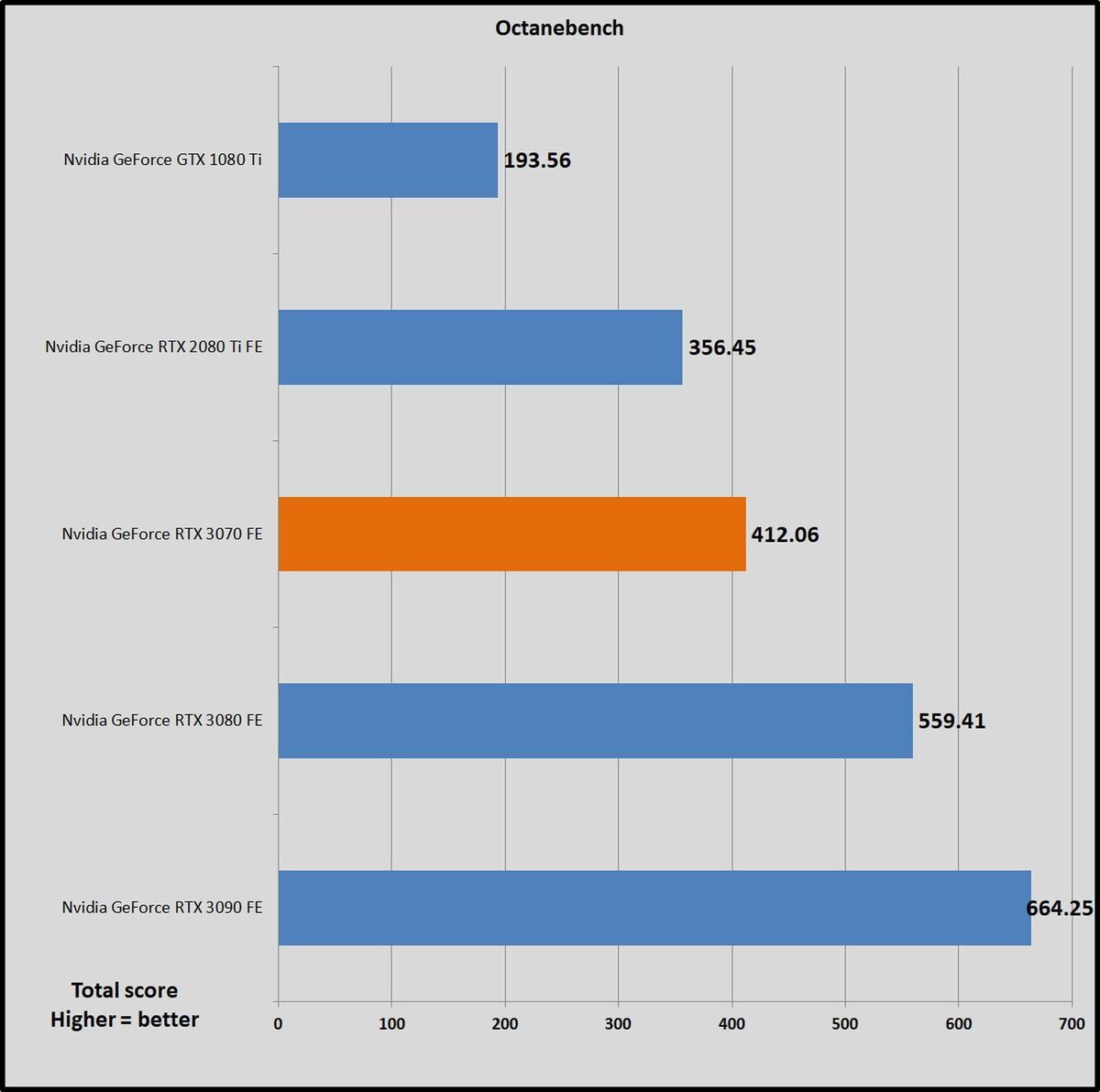 Brad Chacos/IDG
Brad Chacos/IDGThe creative conquering is complete. After witnessing back-and-forth results in games, if Nvidia wants hard proof that the $500 GeForce RTX 3070 is faster than the $1,200 RTX 2080 Ti, the company can point to its rendering chops.
Next page: Power, thermals, and noise
Power draw, thermals, and noise
We test power draw by looping the F1 2020 benchmark at 4K for about 20 minutes after we’ve benchmarked everything else. We note the highest reading on our Watts Up Pro meter, which measures the power consumption of our entire test system. The initial part of the race, where all competing cars are onscreen simultaneously, tends to be the most demanding portion.
This isn’t a worst-case test; we removed the Core i7 8700K’s overclock and specifically chose a GPU-bound game running at a GPU-bound resolution to gauge performance when the graphics card is sweating hard. If you’re playing a game that also hammers the CPU, you could see higher overall system power draws. Consider yourself warned.
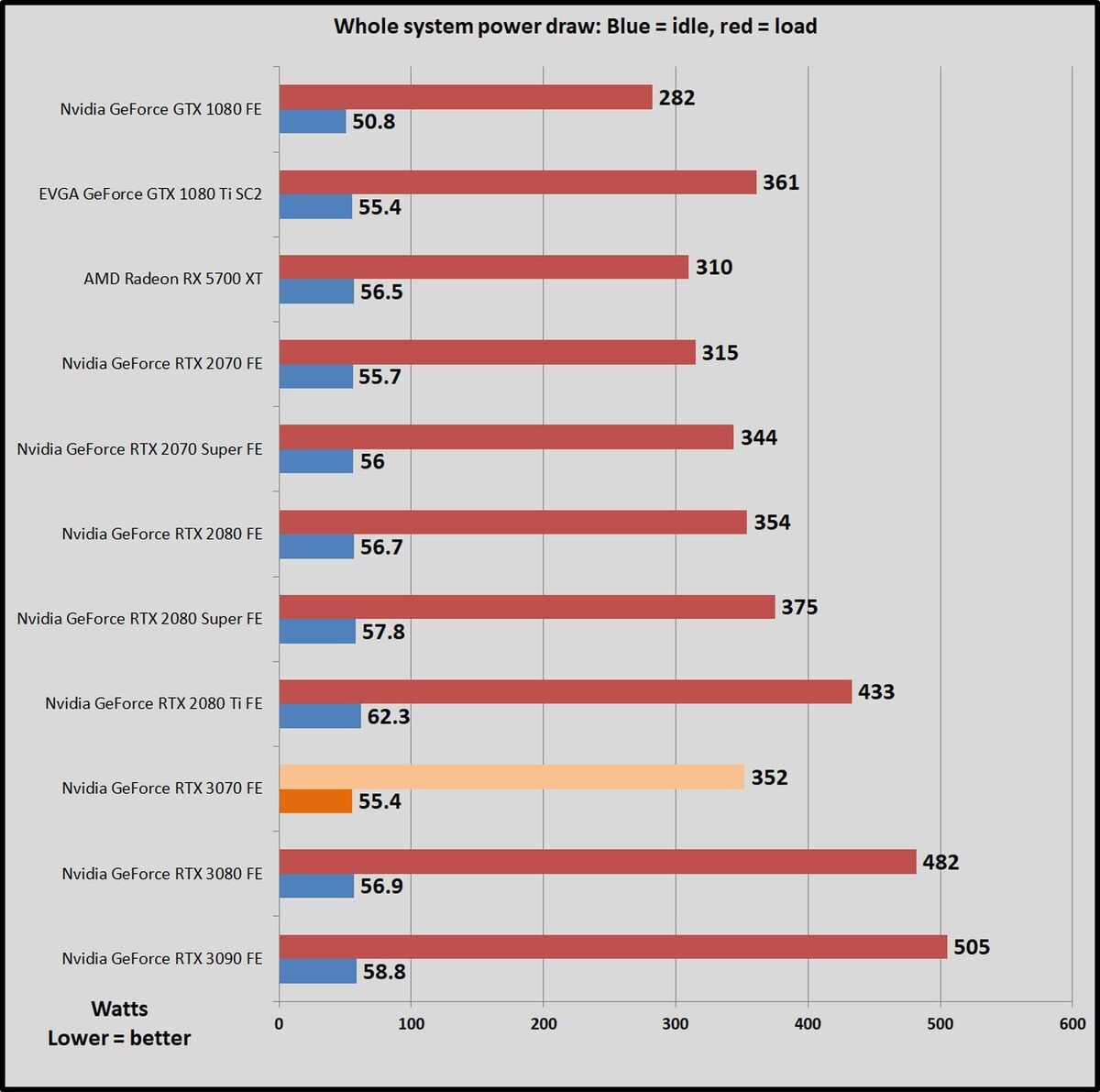 Brad Chacos/IDG
Brad Chacos/IDGFor all the complaints about the RTX 30-series being power hungry, Nvidia’s GeForce RTX 3070 draws considerably less power than the RTX 2080 Ti that it rivals in gaming performance. It requires a bit more juice than the RTX 2070 did, though.
We test thermals by leaving GPU-Z open during the F1 2020 power draw test, noting the highest maximum temperature at the end.
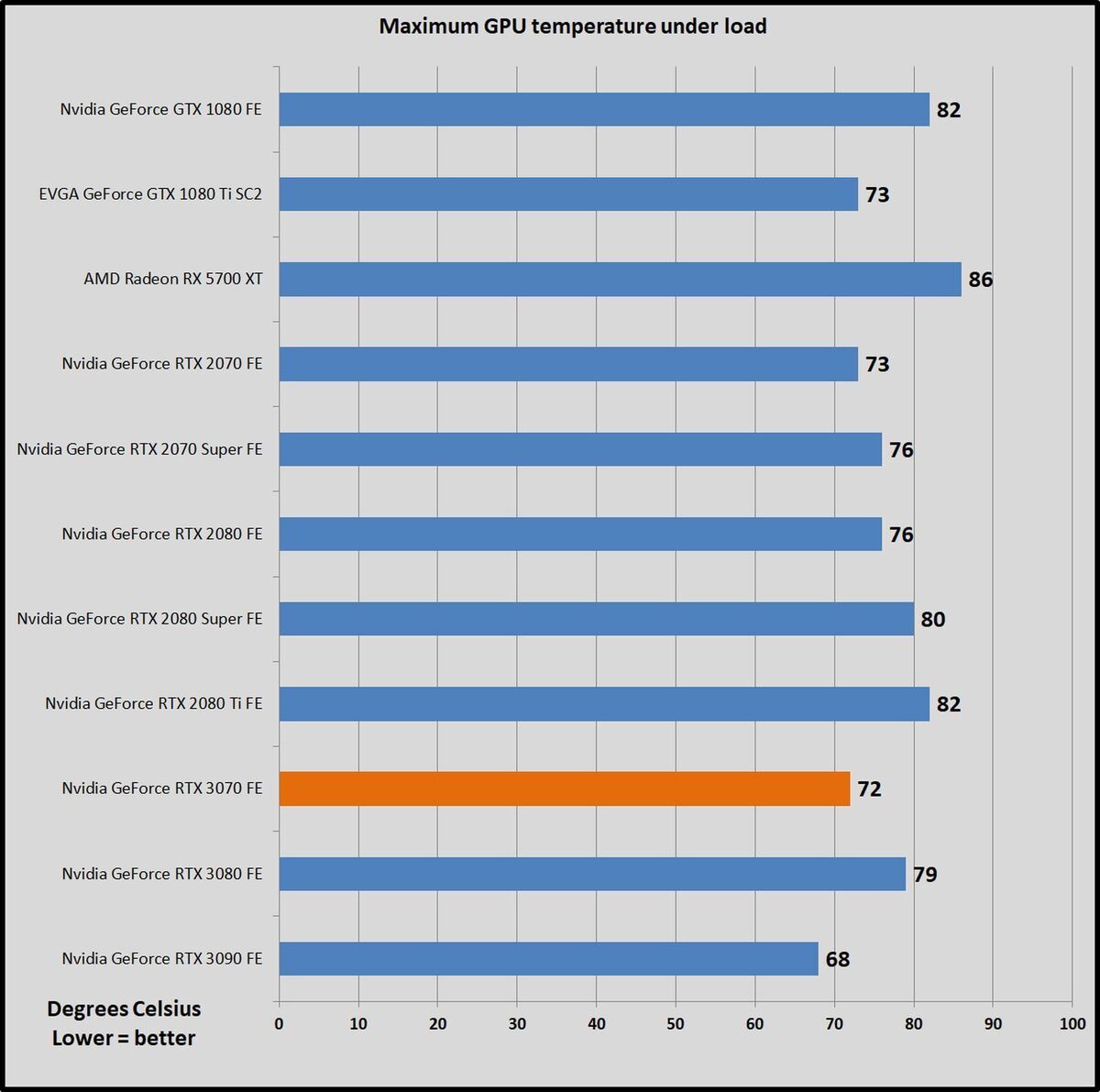 Brad Chacos/IDG
Brad Chacos/IDGNothing to complain about here. The slightly altered RTX 3070 Founders Edition design keeps the GPU at a frigid 72 degrees under an extended load, which compares favorably against well-designed cooling solutions we’ve seen on custom cards in the past. It’s a lot cooler than the (much more powerful) RTX 3080 Founders Edition. That said, while the RTX 3080 FE was very quiet, the much smaller RTX 3070 Founders Edition sounds like your average graphics card. It’s not loud, but it’s definitely not silent.
Next page: Should you buy the Nvidia GeForce RTX 3070 Founders Edition?
Should you buy the Nvidia GeForce RTX 3070 Founders Edition?
If you’re on the hunt for a graphics card capable of feeding a 4K monitor, or high-refresh rate 1440p or 1080p display, the $500 Nvidia GeForce RTX 3070 Founders Edition is a spectacular option. It looks great, runs cool, and keeps reasonably quiet.
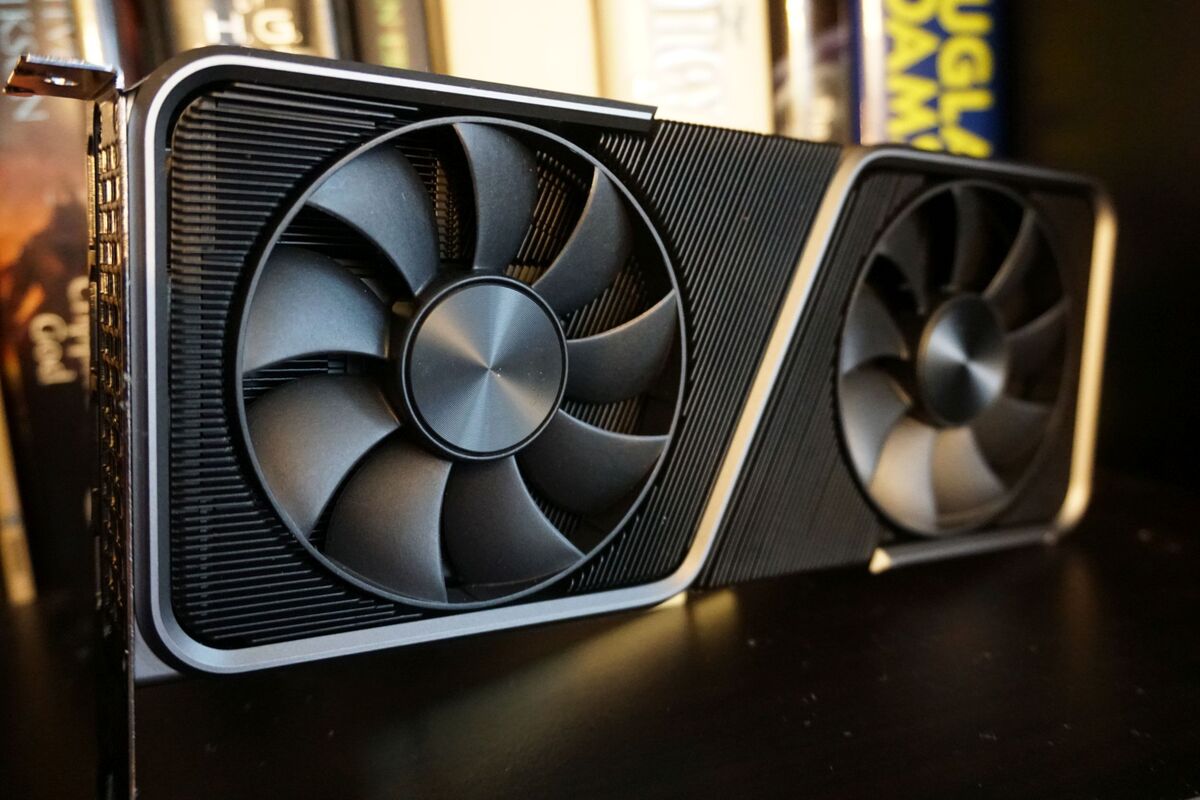 Brad Chacos/IDG
Brad Chacos/IDGThe RTX 3070 isn’t always faster than the RTX 2080 Ti, the $1,200 flagship from the former generation, but they’re always in the same ballpark. It’s just as fast from a practical standpoint, and if you dabble in creative tasks, the upgraded Ampere architecture helps the RTX 3070 blow past the RTX 2080 Ti in rendering benchmarks, all while drawing materially less power. The GeForce RTX 2080 Ti’s bigger 11GB memory capacity might give it the edge in 4K games and creative applications that stress your VRAM buffer, though.
Compared to the GeForce RTX 2070 that preceded it for the same $500 price point, the RTX 2070 winds up 45 to 69 percent faster in GPU-bound scenarios. Generation-on-generation it’s a massive step forward (though to be fair, the RTX 2070 wasn’t much faster than the GTX 1080 that cost a similar amount). Better yet, the increased firepower in the RTX 3070 means you can play games with ray tracing turned on at 1440p or even (sometimes) 4K resolution and still achieve playable frame rates—something you definitely could not say with the RTX 2070.
 Brad Chacos/IDG
Brad Chacos/IDGUnlike the pricier GeForce RTX 3080 and RTX 3090, the GeForce RTX 3070 sticks to 8GB of traditional GDDR6 memory rather than upgrading to the much faster GDDR6X. That gives it an identical memory configuration to the RTX 2070, and an inferior one to the RTX 2080 Ti.
The 8GB memory buffer gives me pause for 4K gaming. It holds up just fine in most (but not all) games today with all visual options cranked to Ultra, but it may hold back performance in a couple of years, especially since the PlayStation 5 and Xbox Series X consoles are both moving to 16GB of VRAM when they launch in a couple of weeks. It’s hard to know what the future holds, but it’s worth considering before you make your purchase. If you plan to hold onto your graphics card for four or five years, and plan to play at 4K resolution, you might want one with more memory. The 8GB VRAM capacity shouldn’t be a concern for high-refresh-rate 1440p gaming, though.
That’s not the only unknown worth considering. Nvidia’s embargo for this GeForce RTX 3070 review is on October 27. Tomorrow, on October 28, AMD will reveal its hotly anticipated “Big Navi” Radeon RX 6000-series graphics cards, powered by the company’s upgraded RDNA 2 architecture. AMD already showed an unnamed Radeon RX 6000 GPU keeping neck-and-neck with the pricier RTX 3080, but stressed it didn’t say which card powered the preview. Rumors also suggest that AMD’s graphics cards could pack much more memory capacity than Nvidia’s RTX 30-series.
The looming specter of the Radeon RX 6000-series makes it hard to give the GeForce RTX 3070 a firm “yes or no” recommendation today. I’d counsel waiting to see what AMD has to offer before making a decision.
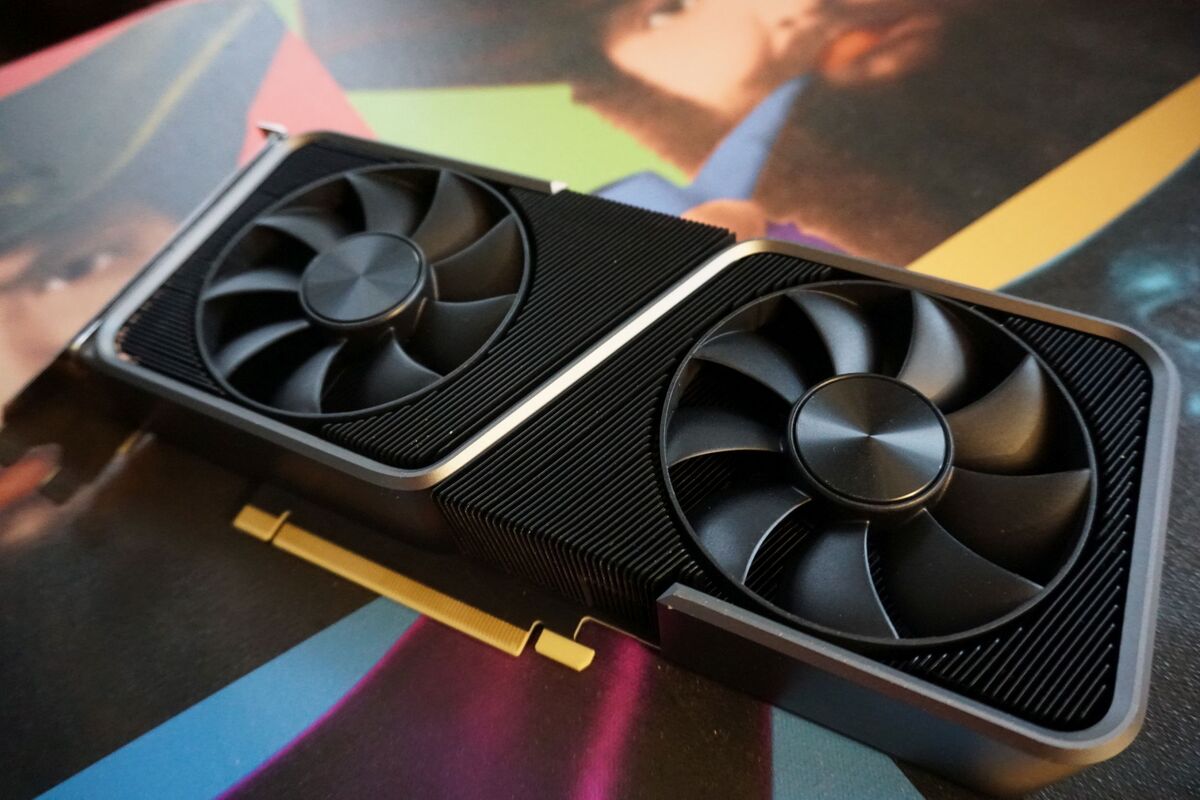 Brad Chacos/IDG
Brad Chacos/IDGTake AMD’s potential counterpunch out of the equation, though, and there’s no question that the $500 GeForce RTX 3070 is a fantastic graphics card. It’s remarkably faster than its direct RTX 2070 predecessor, delivers gaming performance effectively on a par with last generation’s $1,200 flagship (and much better creative rendering performance) while drawing less power, and runs very cool without getting too noisy. Nvidia’s Founders Edition design continues to rock my socks aesthetically too. I wish Nvidia included more memory capacity in the RTX 3070 for people wanting to play at 4K resolution, but other than that, there’s not much to complain about. The GeForce RTX 3070 will melt your face for a stunning $700 less than you used to have to pay for this level of performance.
But you should still wait to see what AMD has on tap before buying one. The sky-high rating we awarded this card might not prove long-lived. Fortunately, while reviews are going live today, the RTX 3070 doesn’t actually hit the streets until October 29, the day after AMD’s Radeon RX 6000 reveal. We don’t expect AMD to hard-launch its new-look Radeon GPUs immediately, but regardless, the timing of all this means you should be much better informed before being asked to plunk down your hard-earned cash on the RTX 3070.




